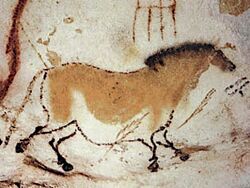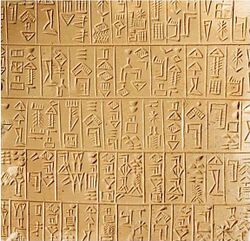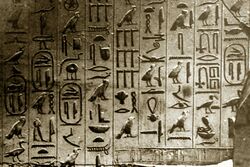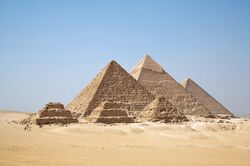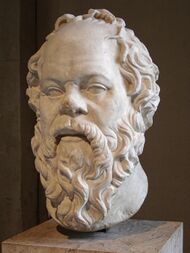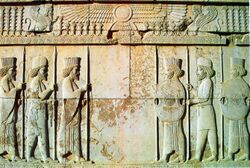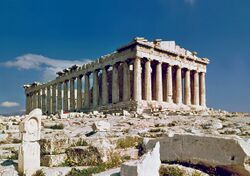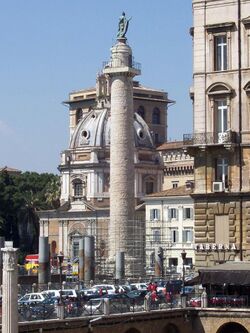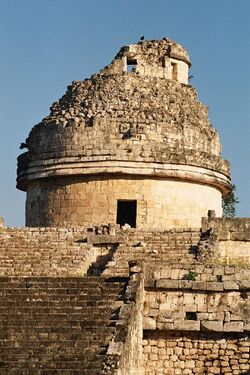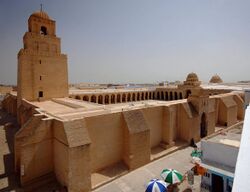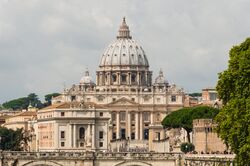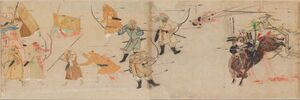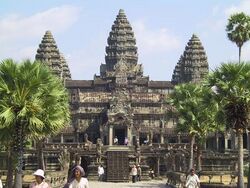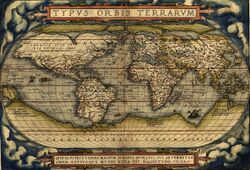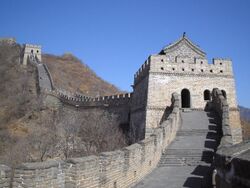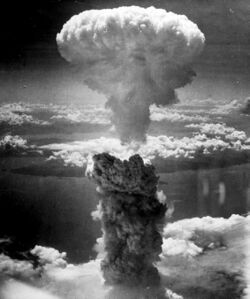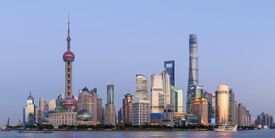History of the world
Topic: History
 From HandWiki - Reading time: 68 min
From HandWiki - Reading time: 68 min
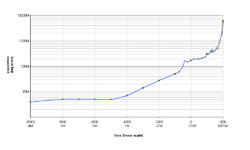
The history of the world, in common parlance, is the history of humanity (or human history), as determined from archeology, anthropology, genetics, linguistics, and other disciplines; and, for periods since the invention of writing, from recorded history and from secondary sources and studies.
Humanity's written history was preceded by its prehistory, beginning with the Palaeolithic Era ("Old Stone Age"), followed by the Neolithic Era ("New Stone Age"). The Neolithic saw the Agricultural Revolution begin, between 8000 and 5000 BCE, in the Near East's Fertile Crescent. During this period, humans began the systematic husbandry of plants and animals.[2] As agriculture advanced, most humans transitioned from a nomadic to a settled lifestyle as farmers in permanent settlements. The relative security and increased productivity provided by farming allowed communities to expand into increasingly larger units, fostered by advances in transportation.
Whether in prehistoric or historic times, people always needed to be near reliable sources of potable water. Settlements developed on river banks as early as 3000 BCE in Mesopotamia,[3] on the banks of Egypt's Nile River,[4][5] in the Indus River valley,[6] and along China's rivers.[7][8] As farming developed, grain agriculture became more sophisticated and prompted a division of labour to store food between growing seasons. Labour divisions led to the rise of a leisured upper class and the development of cities, which provided the foundation for civilization. The growing complexity of human societies necessitated systems of accounting and writing.
With civilizations flourishing, ancient history ("Antiquity," including the Classical Age,[9] up to about 500 CE[10]) saw the rise and fall of empires. Post-classical history (the "Middle Ages," c. 500–1500 CE,[11]) witnessed the rise of Christianity, the Islamic Golden Age (c. 750 CE – c. 1258 CE), and the early Italian Renaissance (from around 1300 CE). The mid-15th-century introduction of movable-type printing in Europe[12] revolutionized communication and facilitated ever wider dissemination of information, hastening the end of the Middle Ages and ushering in the Scientific Revolution.[13] The Early Modern Period, sometimes referred to as the "European Age and Era of the Islamic Gunpowders",[14] from about 1500 to 1800,[15] included the Age of Enlightenment and the Age of Exploration. By the 18th century, the accumulation of knowledge and technology had reached a critical mass that brought about the Industrial Revolution[16] and began the Late Modern Period, which started around 1800 and has continued through the present.[11]
This scheme of historical periodization (dividing history into Antiquity, Post-Classical, Early Modern, and Late Modern periods) was developed for, and applies best to, the history of the Old World, particularly Europe and the Mediterranean. Outside this region, including ancient China and ancient India, historical timelines unfolded differently. However, by the 18th century, due to extensive world trade and colonization, the histories of most civilizations had become substantially intertwined, a process known as globalization. In the last quarter-millennium, the rates of growth of population, knowledge, technology, communications, commerce, weapons destructiveness, and environmental degradation have greatly accelerated, creating opportunities and perils that now confront the planet's human communities.[17]
Prehistory
Early humans
Genetic measurements indicate that the ape lineage which would lead to Homo sapiens diverged from the lineage that would lead to chimpanzees and bonobos, the closest living relatives of modern humans, around 4.6 to 6.2 million years ago.[18] Anatomically modern humans arose in Africa about 300,000 years ago,[19] and reached behavioural modernity about 50,000 years ago.[20]
Modern humans spread rapidly from Africa into the frost-free zones of Europe and Asia around 60,000 years ago.[21] The rapid expansion of humankind to North America and Oceania took place at the climax of the most recent ice age, when temperate regions of today were extremely inhospitable. Yet, humans had colonized nearly all the ice-free parts of the globe by the end of the Ice Age, some 12,000 years ago.[22] Other hominids such as Homo erectus had been using simple wood and stone tools for millennia, but as time progressed, tools became far more refined and complex.
Perhaps as early as 1.8 million years ago, but certainly by 500,000 years ago, humans began using fire for heat and cooking.[23] They also developed language in the Paleolithic period[24] and a conceptual repertoire that included systematic burial of the dead and adornment of the living. Early artistic expression can be found in the form of cave paintings and sculptures made from ivory, stone, and bone, showing a spirituality generally interpreted as animism, or even shamanism.[25] During this period, all humans lived as hunter-gatherers, and were generally nomadic.[26] Archaeological and genetic data suggest that the source populations of Paleolithic hunter-gatherers survived in sparsely wooded areas and dispersed through areas of high primary productivity while avoiding dense forest cover.[27]
Rise of civilization
The Neolithic Revolution, beginning around 10,000 BCE, saw the development of agriculture, which fundamentally changed the human lifestyle. Farming developed around 10,000 BCE in the Middle East, around 7000 BCE in what is now China, around 6000 BCE in the Indus Valley and Europe, and around 4000 BCE in the Americas.[28] Cultivation of cereal crops and the domestication of animals occurred around 8500 BCE in the Middle East, where wheat and barley were the first crops and sheep and goats were domesticated.[29] In the Indus Valley, crops were cultivated by 6000 BCE, along with domesticated cattle. The Yellow River valley in China cultivated millet and other cereal crops by about 7000 BCE, but the Yangtze valley domesticated rice earlier, by at least 8000 BCE. In the Americas, sunflowers were cultivated by about 4000 BCE, and maize and beans were domesticated in Central America by 3500 BCE. Potatoes were first cultivated in the Andes Mountains of South America, where the llama was also domesticated.[28] Metal-working, starting with copper around 6000 BCE, was first used for tools and ornaments. Gold soon followed, with its main use being for ornaments. The need for metal ores stimulated trade, as many of the areas of early human settlement were lacking in ores. Bronze, an alloy of copper and tin, was first known from around 2500 BCE, but did not become widely used until much later.[30]
Though early proto-cities appeared at Jericho and Catal Huyuk around 6000 BCE,[31] the first civilizations did not emerge until around 3000 BCE in Egypt[32] and Mesopotamia.[33] These cultures gave birth to the invention of the wheel,[34] mathematics,[35] bronze-working, sailing boats, the pottery wheel, woven cloth, construction of monumental buildings,[36] and writing.[37] Writing developed independently and at different times in five areas of the world:[38] Egypt (c. 3200 BCE),[38] India (c. 3200 BCE),[39] Mesopotamia (c. 3000 BCE),[40] China (c. 1600 BCE),[41] and Mesoamerica (c. 600 BCE).[38]
Farming permitted far denser populations, which in time organized into states. Agriculture also created food surpluses that could support people not directly engaged in food production.[42] The development of agriculture permitted the creation of the first cities. These were centres of trade, manufacturing and political power.[43] Cities established a symbiosis with their surrounding countrysides, absorbing agricultural products and providing, in return, manufactured goods and varying degrees of military control and protection.
The development of cities was synonymous with the rise of civilization.[lower-alpha 1] Early civilizations arose first in Lower Mesopotamia (3000 BCE),[45][46] followed by Egyptian civilization along the Nile River (3000 BCE),[5] the Harappan civilization in the Indus River Valley (in present-day India and Pakistan; 2500 BCE),[47][48] and Chinese civilization along the Yellow and Yangtze Rivers (2200 BCE).[7][8] These societies developed a number of unifying characteristics, including a central government, a complex economy and social structure, sophisticated language and writing systems, and distinct cultures and religions. Writing facilitated the administration of cities, the expression of ideas, and the preservation of information.[49]
Entities such as the Sun, Moon, Earth, sky, and sea were often deified.[50] Shrines developed, which evolved into temple establishments, complete with a complex hierarchy of priests and priestesses and other functionaries. Typical of the Neolithic was a tendency to worship anthropomorphic deities. Among the earliest surviving written religious scriptures are the Egyptian Pyramid Texts, the oldest of which date to between 2400 and 2300 BCE.[51]
Ancient history
Cradles of civilization
The Bronze Age is part of the three-age system (Stone Age, Bronze Age, Iron Age) that for some parts of the world describes effectively the early history of civilization. During this era the most fertile areas of the world saw city-states and the first civilizations develop. These were concentrated in fertile river valleys: the Tigris and Euphrates in Mesopotamia, the Nile in Egypt,[52] the Indus in the Indian subcontinent,[47] and the Yangtze and Yellow Rivers in China.
Sumer, located in Mesopotamia, is the first known complex civilization, developing the first city-states in the 4th millennium BCE.[46] It was in these cities that the earliest known form of writing, cuneiform script, appeared around 3000 BCE.[38][53] Cuneiform writing began as a system of pictographs. These pictorial representations eventually became simplified and more abstract.[53] Cuneiform texts were written on clay tablets, on which symbols were drawn with a blunt reed used as a stylus.[38] Writing made the administration of a large state far easier.
Transport was facilitated by waterways—by rivers and seas. The Mediterranean Sea, at the juncture of three continents, fostered the projection of military power and the exchange of goods, ideas, and inventions. This era also saw new land technologies, such as horse-based cavalry and chariots, that allowed armies to move faster.
These developments led to the rise of territorial states and empires. In Mesopotamia there prevailed a pattern of independent warring city-states and of a loose hegemony shifting from one city to another.[citation needed] In Egypt, by contrast, first there was a dual division into Upper and Lower Egypt which was shortly followed by unification of all the valley around 3100 BCE, followed by permanent pacification.[54] In Crete the Minoan civilization had entered the Bronze Age by 2700 BCE and is regarded as the first civilization in Europe.[55] Over the next millennia, other river valleys saw monarchical empires rise to power.[citation needed] In the 25th – 21st centuries BCE, the empires of Akkad and Sumer arose in Mesopotamia.[56]
Over the following millennia, civilizations developed across the world. Trade increasingly became a source of power as states with access to important resources or controlling important trade routes rose to dominance.[citation needed] By 1400 BCE, Mycenaean Greece began to develop.[57] In India this era was the Vedic period, which laid the foundations of Hinduism and other cultural aspects of early Indian society, and ended in the 6th century BCE.[58] From around 550 BCE, many independent kingdoms and republics known as the Mahajanapadas were established across the subcontinent.[59]
As complex civilizations arose in the Eastern Hemisphere, the indigenous societies in the Americas remained relatively simple and fragmented into diverse regional cultures. During the formative stage in Mesoamerica (about 1500 BCE to 500 CE), more complex and centralized civilizations began to develop, mostly in what is now Mexico, Central America, and Peru. They included civilizations such as the Olmec, Maya, Zapotec, Moche, and Nazca. They developed agriculture, growing maize, chili peppers, cocoa, tomatoes, and potatoes, crops unique to the Americas, and creating distinct cultures and religions. These ancient indigenous societies would be greatly affected, for good and ill, by European contact during the early modern period.
Axial Age
Beginning in the 8th century BCE, the "Axial Age" saw the development of a set of transformative philosophical and religious ideas, mostly independently, in many different places.[citation needed] Chinese Confucianism, Indian Buddhism and Jainism, and Jewish monotheism are all claimed by some scholars to have developed in the 6th century BCE. (Karl Jaspers' Axial-Age theory also includes Persian Zoroastrianism, but other scholars dispute his timeline for Zoroastrianism.) In the 5th century BCE, Socrates and Plato made substantial advances in the development of ancient Greek philosophy.
In the East, three schools of thought would dominate Chinese thinking well into the 20th century. These were Taoism, Legalism, and Confucianism. The Confucian tradition, which would become particularly dominant, looked for political morality not to the force of law but to the power and example of tradition. Confucianism would later spread to the Korean Peninsula and toward Japan .
In the West, the Ancient Greece philosophical tradition, represented by Socrates, Plato, Aristotle, and other philosophers,[60] along with accumulated science, technology, and culture, diffused throughout Europe, Egypt, the Middle East, and Northwest India, starting in the 4th century BCE after the conquests of Alexander III of Macedon (Alexander the Great).[61]
Regional empires
The millennium from 500 BCE to 500 CE saw a series of empires of unprecedented size develop. Well-trained professional armies, unifying ideologies, and advanced bureaucracies created the possibility for emperors to rule over large domains whose populations could attain numbers upwards of tens of millions of subjects. The great empires depended on military annexation of territory and on the formation of defended settlements to become agricultural centres. The relative peace that the empires brought encouraged international trade, most notably the massive trade routes in the Mediterranean, the maritime trade web in the Indian Ocean, and the Silk Road. In southern Europe, the Ancient Greece (and later the Romans), in an era known as "classical antiquity," established cultures whose practices, laws, and customs are considered the foundation of contemporary Western culture.

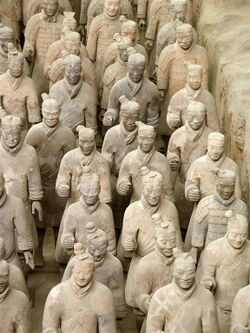
There were a number of regional empires during this period. The kingdom of the Medes helped to destroy the Assyrian Empire in tandem with the nomadic Scythians and the Babylonians. Nineveh, the capital of Assyria, was sacked by the Medes in 612 BCE.[62] The Median Empire gave way to successive Iranian empires, including the Achaemenid Empire (550–330 BCE), the Parthian Empire (247 BCE–224 CE), and the Sasanian Empire (224–651 CE).
Several empires began in modern-day Greece. First was the Delian League (from 477 BCE)[63] and the succeeding Athenian Empire (454–404 BCE), centred in present-day Greece. Later, Alexander the Great (356–323 BCE), of Macedon, founded an empire of conquest, extending from present-day Greece to present-day India.[64][65] The empire divided shortly after his death, but the influence of his Hellenistic successors made for an extended Hellenistic period (323–31 BCE)[66] throughout the region.
In Asia, the Maurya Empire (322–185 BCE) existed in present-day India;[67] in the 3rd century BCE, most of South Asia was united to the Maurya Empire by Chandragupta Maurya and flourished under Ashoka the Great. From the 3rd century CE, the Gupta dynasty oversaw the period referred to as ancient India's Golden Age. From the 4th to 6th centuries, northern India was ruled by the Gupta Empire. In southern India, three prominent Dravidian kingdoms emerged: the Cheras,[citation needed] Cholas,[68] and Pandyas. The ensuing stability contributed to heralding in the golden age of Hindu culture in the 4th and 5th centuries.
In Europe, the Roman Empire, centered in present-day Italy, began in the 7th century BCE.[69] In the 3rd century BCE the Roman Republic began expanding its territory through conquest and alliances.[70] By the time of Augustus (63 BCE – 14 CE), the first Roman Emperor, Rome had already established dominion over most of the Mediterranean. The empire would continue to grow, controlling much of the land from England to Mesopotamia, reaching its greatest extent under the emperor Trajan (died 117 CE). In the 3rd century CE, the empire split into western and eastern regions, with (usually) separate emperors. The Western empire would fall, in 476 CE, to German influence under Odoacer. The eastern empire, now known as the Byzantine Empire, with its capital at Constantinople, would continue for another thousand years, until Constantinople was conquered by the Ottoman Empire in 1453.
In China, the Qin dynasty (221–206 BCE), the first imperial dynasty of China, was followed by the Han Empire (206 BCE – 220 CE). The Han Dynasty was comparable in power and influence to the Roman Empire that lay at the other end of the Silk Road. Han China developed advanced cartography, shipbuilding, and navigation. The Chinese invented blast furnaces, and created finely tuned copper instruments. As with other empires during the Classical Period, Han China advanced significantly in the areas of government, education, mathematics, astronomy, technology, and many others.[71]
In Africa, the Kingdom of Aksum, centred in present-day Ethiopia, established itself by the 1st century CE as a major trading empire, dominating its neighbours in South Arabia and Kush and controlling the Red Sea trade. It minted its own currency and carved enormous monolithic steles such as the Obelisk of Axum to mark their emperors' graves.
Successful regional empires were also established in the Americas, arising from cultures established as early as 2500 BCE.[72] In Mesoamerica, vast pre-Columbian societies were built, the most notable being the Zapotec Empire (700 BCE – 1521 CE),[73] and the Maya civilization, which reached its highest state of development during the Mesoamerican Classic period (c. 250–900 CE),[74] but continued throughout the Post-Classic period until the arrival of the Spanish in the 16th century CE. Maya civilization arose as the Olmec mother culture gradually declined. The great Mayan city-states slowly rose in number and prominence, and Maya culture spread throughout the Yucatán and surrounding areas. The later empire of the Aztecs was built on neighbouring cultures and was influenced by conquered peoples such as the Toltecs.
Some areas experienced slow but steady technological advances, with important developments such as the stirrup and moldboard plough arriving every few centuries. There were, however, in some regions, periods of rapid technological progress. Most important, perhaps, was the Hellenistic period in the region of the Mediterranean, during which hundreds of technologies were invented.[75] Such periods were followed by periods of technological decay, as during the Roman Empire's decline and fall and the ensuing early medieval period.
Declines, falls, and resurgence
The ancient empires faced common problems associated with maintaining huge armies and supporting a central bureaucracy. These costs fell most heavily on the peasantry, while land-owning magnates increasingly evaded centralized control and its costs. Barbarian pressure on the frontiers hastened internal dissolution. China 's Han dynasty fell into civil war in 220 CE, beginning the Three Kingdoms period, while its Roman counterpart became increasingly decentralized and divided about the same time in what is known as the Crisis of the Third Century. The great empires of Eurasia were all located on temperate and subtropical coastal plains. From the Central Asian steppes, horse-based nomads, mainly Mongols and Turks, dominated a large part of the continent. The development of the stirrup and the breeding of horses strong enough to carry a fully armed archer made the nomads a constant threat to the more settled civilizations.
The gradual break-up of the Roman Empire, spanning several centuries after the 2nd century CE, coincided with the spread of Christianity outward from the Middle East.[76] The Western Roman Empire fell under the domination of Germanic tribes in the 5th century,[77] and these polities gradually developed into a number of warring states, all associated in one way or another with the Catholic Church.[78] The remaining part of the Roman Empire, in the eastern Mediterranean, continued as what came to be called the Byzantine Empire.[79] Centuries later, a limited unity would be restored to western Europe through the establishment in 962 of a revived "Roman Empire",[80] later called the Holy Roman Empire,[81] comprising a number of states in what is now Germany, Austria, Switzerland, Czech Republic, Belgium, Italy, and parts of France.[82][83]
In China, dynasties would rise and fall, but, by sharp contrast to the Mediterranean-European world, dynastic unity would be restored. After the fall of the Eastern Han Dynasty[84] and the demise of the Three Kingdoms, nomadic tribes from the north began to invade in the 4th century, eventually conquering areas of northern China and setting up many small kingdoms.[citation needed] The Sui Dynasty successfully reunified the whole of China[85] in 581,[86] and laid the foundations for a Chinese golden age under the Tang dynasty (618–907).
Post-classical history
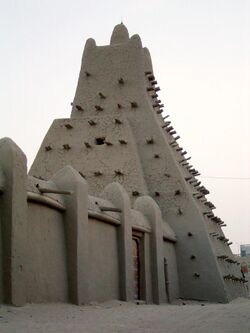
The term "Post-classical Era", though derived from the Eurocentric name of the era of "Classical antiquity", takes in a broader geographic sweep. The era is commonly dated from the 5th-century fall of the Western Roman Empire, which fragmented into many separate kingdoms, some of which would later be confederated under the Holy Roman Empire.
The Eastern Roman, or Byzantine, Empire survived until late in the Post-classical, or Medieval, period.
The Post-classical period also encompasses the Early Muslim conquests, the subsequent Islamic Golden Age, and the commencement and expansion of the Arab slave trade, followed by the Mongol invasions of the Middle East, Central Asia, and Eastern Europe[citation needed] and the founding around 1280 of the Ottoman Empire.[87] South Asia saw a series of middle kingdoms of India, followed by the establishment of Islamic empires in India.
In western Africa, the Mali Empire and the Songhai Empire developed. On the southeast coast of Africa, Arabic ports were established where gold, spices, and other commodities were traded. This allowed Africa to join the Southeast Asia trading system, bringing it contact with Asia; this, along with Muslim culture, resulted in the Swahili culture.
China experienced the successive Sui, Tang, Song, Yuan, and early Ming dynasties. Middle Eastern trade routes along the Indian Ocean, and the Silk Road through the Gobi Desert, provided limited economic and cultural contact between Asian and European civilizations.
During the same period, civilizations in the Americas, such as the Inca, Maya, and Aztecs, reached their zenith. All would be compromised by, then conquered after, contact with European colonists at the beginning of the Modern period.
Greater Middle East
Prior to the advent of Islam in the 7th century, the Middle East was dominated by the Byzantine Empire and the Persian Sasanian Empire, which frequently fought each other for control of several disputed regions. This was also a cultural battle, with the Byzantine Hellenistic and Christian culture competing against the Persian Iranian traditions and Zoroastrian religion. The formation of the Islamic religion created a new contender that quickly surpassed both of these empires. Islam greatly affected the political, economic, and military history of the Old World, especially the Middle East.
From their centre on the Arabian Peninsula, Muslims began their expansion during the early Postclassical Era. By 750 CE, they came to conquer most of the Near East, North Africa, and parts of Europe, ushering in an era of learning, science, and invention known as the Islamic Golden Age. The knowledge and skills of the ancient Near East, Greece, and Persia were preserved in the Postclassical Era by Muslims, who also added new and important innovations from outside, such as the manufacture of paper from China and decimal positional numbering from India.
Much of this learning and development can be linked to geography. Even prior to Islam's presence, the city of Mecca had served as a centre of trade in Arabia, and the Islamic prophet Muhammad himself was a merchant. With the new Islamic tradition of the Hajj, the pilgrimage to Mecca, the city became even more a centre for exchanging goods and ideas. The influence held by Muslim merchants over African-Arabian and Arabian-Asian trade routes was tremendous. As a result, Islamic civilization grew and expanded on the basis of its merchant economy, in contrast to the Europeans, Indians, and Chinese, who based their societies on an agricultural landholding nobility. Merchants brought goods and their Islamic faith to China, India, Southeast Asia, and the kingdoms of western Africa, and returned with new discoveries and inventions.

Motivated by religion and dreams of conquest, European leaders launched a number of Crusades to try to roll back Muslim power and retake the Holy Land. The Crusades were ultimately unsuccessful and served more to weaken the Byzantine Empire, especially with the 1204 sack of Constantinople. The Byzantine Empire began to lose increasing amounts of territory to the Ottoman Turks. Arab domination of the region ended in the mid-11th century with the arrival of the Seljuq Turks, migrating south from the Turkic homelands in Central Asia. In the early 13th century, a new wave of invaders, the Mongol Empire, swept through the region but were eventually eclipsed by the Turks[citation needed] and the founding of the Ottoman Empire in modern-day Turkey around 1280.[87]
North Africa saw the rise of polities formed by the Berbers, such as the Marinid dynasty in Morocco, the Zayyanid dynasty in Algeria, and the Hafsid dynasty in Tunisia. The region will later be called the Barbary Coast and will host pirates and privateers who will use several North African ports for their raids against the coastal towns of several European countries in search of slaves to be sold in North African markets as part of the Barbary slave trade.
Starting with the Sui dynasty (581–618), the Chinese began expanding into eastern Central Asia, and confronted Turkic nomads, who were becoming the most dominant ethnic group in Central Asia.[88][89] Originally the relationship was largely cooperative, but in 630 the Tang dynasty began an offensive against the Turks,[90] capturing areas of the Mongolian Ordos Desert. In the 8th century, Islam began to penetrate the region and soon became the sole faith of most of the population, though Buddhism remained strong in the east.[weasel words][citation needed] The desert nomads of Arabia could militarily match the nomads of the steppe, and the early Arab Empire gained control over parts of Central Asia.[88] The Hephthalites were the most powerful of the nomad groups in the 6th and 7th centuries, and controlled much of the region. In the 9th through 13th centuries the region was divided among several powerful states, including the Samanid Empire [citation needed] the Seljuk Empire,[91] and the Khwarezmid Empire. The largest empire to rise out of Central Asia developed when Genghis Khan united the tribes of Mongolia. The Mongol Empire spread to comprise all of Central Asia and China as well as large parts of Russia and the Middle East.[citation needed] After Genghis Khan died in 1227,[92] most of Central Asia continued to be dominated by a successor state, Chagatai Khanate. In 1369, Timur, a Turkic leader in the Mongol military tradition, conquered most of the region and founded the Timurid Empire. Timur's large empire collapsed soon after his death, however. The region then became divided into a series of smaller khanates that were created by the Uzbeks. These included the Khanate of Khiva, the Khanate of Bukhara, and the Khanate of Kokand, all of whose capitals are located in present-day Uzbekistan.
In the aftermath of the Byzantine–Sasanian wars, the Caucasus saw Armenia and Georgia flourish as independent realms free from foreign suzerainty. However with the Byzantine and Sasanian empires exhausted from war, the Arabs were given the oppurtunity to proceed to the Caucasus during the early Muslim conquests. By the 13th century, the arrival of the Mongols saw the region invaded and subjugated once again.
Europe
Europe during the Early Middle Ages was characterized by depopulation, deurbanization, and barbarian invasion, all of which had begun in Late Antiquity. The barbarian invaders formed their own new kingdoms in the remains of the Western Roman Empire. In the 7th century, North Africa and the Middle East, once part of the Eastern Roman Empire, became part of the Caliphate after conquest by Muhammad's successors. Although there were substantial changes in society and political structures, most of the new kingdoms incorporated as many of the existing Roman institutions as they could. Christianity expanded in western Europe, and monasteries were founded. In the 7th and 8th centuries the Franks, under the Carolingian dynasty, established an empire covering much of western Europe;[citation needed] it lasted until the 9th century, when it succumbed to pressure from new invaders—the Vikings,[93] Magyars, and Saracens.
During the High Middle Ages, which began after 1000, the population of Europe increased greatly as technological and agricultural innovations allowed trade to flourish and crop yields to increase. Manorialism—the organization of peasants into villages that owed rents and labour service to nobles—and feudalism—a political structure whereby knights and lower-status nobles owed military service to their overlords in return for the right to rents from lands and manors—were two of the ways of organizing medieval society that developed during the High Middle Ages. Kingdoms became more centralized after the decentralizing effects of the break-up of the Carolingian Empire. The Crusades, first preached in 1095, were an attempt by western Christians from nations such as the Kingdom of England, the Kingdom of France and the Holy Roman Empire to regain control of the Holy Land from the Muslims and succeeded for long enough to establish some Christian states in the Near East. Italian merchants imported slaves to work in households or in sugar processing.[citation needed] Intellectual life was marked by scholasticism and the founding of universities, while the building of Gothic cathedrals was one of the outstanding artistic achievements of the age.
The Late Middle Ages were marked by difficulties and calamities. Famine, plague, and war devastated the population of western Europe.[citation needed] The Black Death alone killed approximately 75 to 200 million people between 1347 and 1350.[94][95] It was one of the deadliest pandemics in human history. Starting in Asia, the disease reached Mediterranean and western Europe during the late 1340s,[96] and killed tens of millions of Europeans in six years; between a third and a half of the population perished.
The Middle Ages witnessed the first sustained urbanization of northern and western Europe. Many modern European states owe their origins to events unfolding in the Middle Ages; present European political boundaries are, in many regards, the result of military and dynastic events during this tumultuous period.[citation needed][contradictory](see see here - (self promotion?)) The Middle Ages lasted until the beginning of the Early modern period in the 16th century,[15] marked by the rise of nation states,[97] the division of Western Christianity in the Reformation,[98] the rise of humanism in the Italian Renaissance,[99] and the beginnings of European overseas expansion which allowed for the Columbian Exchange.
In Central and Eastern Europe, in 1386, the Kingdom of Poland and the Grand Duchy of Lithuania (the latter including territories of modern Belarus and Ukraine ), facing depredations by the Teutonic Knights and later also threats from Muscovy, the Crimean Tatars, and the Ottoman Empire, formed a personal union through the marriage of Poland's Queen Jadwiga to Lithuanian Grand Duke Jogaila, who became King Władysław II Jagiełło of Poland. For the next four centuries, until the 18th-century Partitions of the Polish-Lithuanian Commonwealth by Prussia, Russia , and Austria, the two polities conducted a federated condominium, long Europe's largest state, which welcomed diverse ethnicities and religions, including most of the world's Jews, furthered scientific thought (e.g., Copernicus's heliocentric theory), and—in a last-ditch effort to preserve their sovereignty—adopted the Constitution of 3 May 1791, the world's second modern written constitution after the U.S. Constitution that went into effect in 1789.
Sub-Saharan Africa
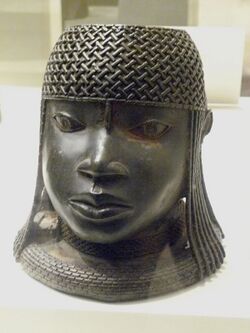
Medieval Sub-Saharan Africa was home to many different civilizations. The Kingdom of Aksum declined in the 7th century as Islam cut it off from its Christian allies and its people moved further into the Ethiopian Highlands for protection. They eventually gave way to the Zagwe dynasty who are famed for their rock cut architecture at Lalibela. The Zagwe would then fall to the Solomonic dynasty who claimed descent from the Aksumite emperors[citation needed] and would rule the country well into the 20th century. In the West African Sahel region, many Islamic empires rose, such as the Ghana Empire, the Mali Empire, the Songhai Empire, and the Kanem–Bornu Empire. They controlled the trans-Saharan trade in gold, ivory, salt and slaves.
South of the Sahel, civilizations rose in the coastal forests where horses and camels could not survive.[citation needed] These include the Yoruba city of Ife, noted for its art,[100] and the Oyo Empire, the Kingdom of Benin of the Edo people centred in Benin City, the Igbo Kingdom of Nri which produced advanced bronze art at Igbo-Ukwu, and the Akan who are noted for their intricate architecture.[citation needed]
Central Africa saw the birth of several states, including the Kingdom of Kongo. In what is now modern Southern Africa, native Africans created various kingdoms such as the Kingdom of Mutapa. They flourished through trade with the Swahili people on the East African coast. They built large defensive stone structures without mortar such as Great Zimbabwe, capital of the Kingdom of Zimbabwe, Khami, capital of Kingdom of Butua, and Danangombe (Dhlo-Dhlo), capital of the Rozwi Empire. The Swahili people themselves were the inhabitants of the East African coast from Kenya to Mozambique who traded extensively with Asians and Arabs, who introduced them to Islam. They built many port cities such as Mombasa, Zanzibar and Kilwa, which were known to Chinese sailors under Zheng He and Islamic geographers.
South Asia
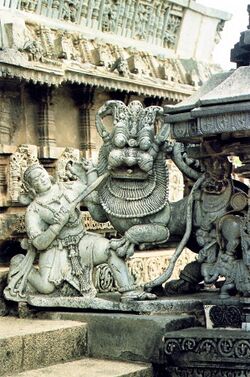
In northern India, after the fall (550 CE) of the Gupta Empire, the region was divided into a complex and fluid network of smaller kingly states.[citation needed]
Early Muslim incursions began in the west in 712 CE, when the Arab Umayyad Caliphate annexed much of present-day Pakistan . Arab military advance was largely halted at that point, but Islam still spread in India, largely due to the influence of Arab merchants along the western coast.
The ninth century saw a Tripartite Struggle for control of northern India, among the Pratihara Empire, the Pala Empire, and the Rashtrakuta Empire. Some of the important states that emerged in India at this time included the Bahmani Sultanate and the Vijayanagara Empire.
Post-classical dynasties in South India included those of the Chalukyas, the Hoysalas, the Cholas, the Islamic Mughals, the Marathas, and the Mysores. Science, engineering, art, literature, astronomy, and philosophy flourished under the patronage of these kings.[citation needed]
Northeast Asia
After a period of relative disunity, China was reunified by the Sui dynasty in 581[citation needed] and under the succeeding Tang dynasty (618–907) China entered a Golden Age.[101] The Tang Empire competed with the Tibetan Empire for control of areas in Inner and Central Asia.[102] The Tang dynasty eventually splintered, however, and after half a century of turmoil the Song dynasty reunified China,[citation needed] when it was, according to William McNeill, the "richest, most skilled, and most populous country on earth".[103] Pressure from nomadic empires to the north became increasingly urgent. By 1142, North China had been lost to the Jurchens in the Jin–Song Wars, and the Mongol Empire[104] conquered all of China in 1279, along with almost half of Eurasia's landmass. After about a century of Mongol Yuan dynasty rule, the ethnic Chinese reasserted control with the founding of the Ming dynasty (1368).
In Japan, the imperial lineage had been established by this time, and during the Asuka period (538–710) the Yamato Province developed into a clearly centralized state.[105] Buddhism was introduced, and there was an emphasis on the adoption of elements of Chinese culture and Confucianism. The Nara period of the 8th century[106] marked the emergence of a strong Japanese state and is often portrayed as a golden age.[citation needed] During this period, the imperial government undertook great public works, including government offices, temples, roads, and irrigation systems.[citation needed] The Heian period (794 to 1185) saw the peak of imperial power, followed by the rise of militarized clans, and the beginning of Japanese feudalism. The feudal period of Japanese history, dominated by powerful regional lords (daimyōs) and the military rule of warlords (shōguns) such as the Ashikaga shogunate and Tokugawa shogunate, stretched from 1185 to 1868. The emperor remained, but mostly as a figurehead, and the power of merchants was weak.
Postclassical Korea saw the end of the Three Kingdoms era, the three kingdoms being Goguryeo, Baekje and Silla. Silla conquered Baekje in 660, and Goguryeo in 668,[107] marking the beginning of the North–South States Period (남북국시대), with Unified Silla in the south and Balhae, a successor state to Goguryeo, in the north.[108] In 892 CE, this arrangement reverted to the Later Three Kingdoms, with Goguryeo (then called Taebong and eventually named Goryeo) emerging as dominant, unifying the entire peninsula by 936.[109] The founding Goryeo dynasty ruled until 1392, succeeded by the Joseon dynasty, which ruled for approximately 500 years.
Southeast Asia
The beginning of the Middle Ages in Southeast Asia saw the fall (550 CE) of the Kingdom of Funan to the Chenla Empire, which was then replaced by the Khmer Empire (802 CE). The Khmer people's capital city, Angkor, was the largest city in the world prior to the industrial age and contained over a thousand temples, the most famous being Angkor Wat.
The Sukhothai (1238 CE) and Ayutthaya (1351 CE) kingdoms were major powers of the Thai people, who were influenced by the Khmer.
Starting in the 9th century, the Pagan Kingdom rose to prominence in modern Myanmar.
Other notable kingdoms of the period include the Srivijayan Empire and the Lavo Kingdom (both coming into prominence in the 7th century), the Champa and the Hariphunchai (both about 750), the Đại Việt (968), Lan Na (13th century), Majapahit (1293), Lan Xang (1354), and the Kingdom of Ava (1364).
This period saw the spread of Islam to present-day Indonesia (beginning in the 13th century) and the emergence of the Malay states, including the Malacca Sultanate and the Bruneian Empire.
In the Philippines, several polities arose during this period, including the Rajahnate of Maynila, the Rajahnate of Cebu, the Rajahnate of Butuan.
Oceania

In the region of Oceania, the Tuʻi Tonga Empire was founded in the 10th century CE and expanded between 1200 and 1500. Tongan culture, language, and hegemony spread widely throughout Eastern Melanesia, Micronesia, and Central Polynesia during this period,[110] influencing East 'Uvea, Rotuma, Futuna, Samoa, and Niue, as well as specific islands and parts of Micronesia (Kiribati, Pohnpei, and miscellaneous outliers), Vanuatu, and New Caledonia (specifically, the Loyalty Islands, with the main island being predominantly populated by the Melanesian Kanak people and their cultures).[111]
At around the same time, a powerful thalassocracy appeared in Eastern Polynesia, centered around the Society Islands, specifically on the sacred Taputapuatea marae, which drew in Eastern Polynesian colonists from places as far away as Hawaii, New Zealand (Aotearoa), and the Tuamotu Islands for political, spiritual and economic reasons, until the unexplained collapse of regular long-distance voyaging in the Eastern Pacific a few centuries before Europeans began exploring the area.
Indigenous written records from this period are virtually nonexistent, as it seems that all Pacific Islanders, with the possible exception of the enigmatic Rapa Nui and their currently undecipherable Rongorongo script, had no writing systems of any kind until after their introduction by European colonists. However, some indigenous prehistories can be estimated and academically reconstructed through careful, judicious analysis of native oral traditions, colonial ethnography, archeology, physical anthropology, and linguistics research.
Americas
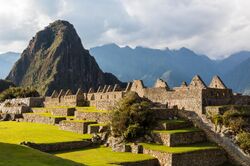
In North America, this period saw the rise of the Mississippian culture in the modern-day United States c. 800 CE, marked by the extensive 12th-century urban complex at Cahokia. The Ancestral Puebloans and their predecessors (9th – 13th centuries) built extensive permanent settlements, including stone structures that would remain the largest buildings in North America until the 19th century.[112]
In Mesoamerica, the Teotihuacan civilization fell and the Classic Maya collapse occurred. The Aztec Empire came to dominate much of Mesoamerica in the 14th and 15th centuries.
In South America, the 14th and 15th centuries saw the rise of the Inca. The Inca Empire of Tawantinsuyu, with its capital at Cusco, spanned the entire Andes, making it the most extensive pre-Columbian civilization. The Inca were prosperous and advanced, known for an excellent road system and unrivaled masonry.
Modern history
In the linear, global, historiographical approach, modern history (the "modern period," the "modern era," "modern times") is the history of the period following post-classical history (in Europe known as the "Middle Ages"), spanning from about 1500 to the present. "Contemporary history" includes events from around 1945 to the present. (The definitions of both terms, "modern history" and "contemporary history", have changed over time, as more history has occurred, and so have their start dates.)[113][114] Modern history can be further broken down into periods:
- The early modern period began around 1500 and ended around 1815. Notable historical milestones included the continued European Renaissance (whose start is dated variously between 1200 and 1401), the Age of Exploration, the Islamic gunpowder empires, the Protestant Reformation,[115][116] and the American Revolution. With the Scientific Revolution, new information about the world was discovered via empirical observation[117] and the scientific method, by contrast with the earlier emphasis on reason and "innate knowledge". The Scientific Revolution received impetus from Johannes Gutenberg's introduction to Europe of printing, using movable type, and from the invention of the telescope and microscope. Globalization was fuelled by international trade and colonization.
- The late modern period began sometime around 1750-1815, as Europe experienced the Industrial Revolution and the military-political turbulence of the French Revolution and the Napoleonic Wars, which were followed by the Pax Britannica. The late modern period continues either to the end of World War II, in 1945, or to the present. Other notable historical milestones included the Great Divergence and the Russian Revolution.
- Contemporary history (a period also dubbed Pax Americana in geopolitics) includes historic events from approximately 1945 that are closely relevant to the present time. Major developments include the Cold War, continual hot wars and proxy wars, the Jet Age, the DNA revolution, the Green Revolution,[lower-alpha 2] artificial satellites and global positioning systems (GPS), development of the supranational European Union, the Information Age, rapid economic development in India and China , increasing terrorism, and a daunting array of global ecological crises headed by the imminent existential threat of runaway global warming.
The defining features of the modern era developed predominantly in Europe, and so different periodizations are sometimes applied to other parts of the world. When the European periods are used globally, this is often in the context of contact with European culture in the Age of Discovery.[119]
In the humanities and social sciences, the norms, attitudes, and practices arising during the modern period are known as modernity. The corresponding terms for post-World War II culture are postmodernity or late modernity.
Early modern period
The "Early Modern period"[lower-alpha 3] was the period between the Middle Ages and the Industrial Revolution—roughly 1500 to 1800.[15] The Early Modern period was characterized by the rise of science, and by increasingly rapid technological progress, secularized civic politics, and the nation state. Capitalist economies began their rise, initially in northern Italian republics such as Genoa. The Early Modern period saw the rise and dominance of mercantilist economic theory, and the decline and eventual disappearance, in much of the European sphere, of feudalism, serfdom, and the power of the Catholic Church. The period included the Protestant Reformation, the disastrous Thirty Years' War, the Age of Exploration, European colonial expansion, the peak of European witch-hunting, the Scientific revolution, and the Age of Enlightenment.[lower-alpha 4]
Renaissance

Europe's Renaissance – the "rebirth" of classical culture, beginning in the 14th century and extending into the 16th – comprised the rediscovery of the classical world's cultural, scientific, and technological achievements, and the economic and social rise of Europe.
The Renaissance engendered a culture of inquisitiveness which ultimately led to Humanism[120] and the Scientific Revolution.[121]
This period, which saw social and political upheavals, and revolutions in many intellectual pursuits, is also celebrated for its artistic developments and the attainments of such polymaths as Leonardo da Vinci and Michelangelo, who inspired the term "Renaissance man."
European expansion
During this period, European powers came to dominate most of the world. Although the most developed regions of European classical civilization were more urbanized than any other region of the world, European civilization had undergone a lengthy period of gradual decline and collapse. During the Early Modern Period, Europe was able to regain its dominance; historians still debate the causes.
Europe's success in this period stands in contrast to other regions. For example, one of the most advanced civilizations of the Middle Ages was China. It had developed an advanced monetary economy by 1000 CE. China had a free peasantry who were no longer subsistence farmers, and could sell their produce and actively participate in the market. According to Adam Smith, writing in the 18th century, China had long been one of the richest, most fertile, best cultivated, most industrious, most urbanized, and most prosperous countries in the world. It enjoyed a technological advantage and had a monopoly in cast iron production, piston bellows, suspension bridge construction, printing, and the compass. However, it seemed to have long since stopped progressing. Marco Polo, who visited China in the 13th century, describes its cultivation, industry, and populousness almost in the same terms as travellers would in the 18th century.
One theory of Europe's rise holds that Europe's geography played an important role in its success. The Middle East, India and China are all ringed by mountains and oceans but, once past these outer barriers, are nearly flat. By contrast, the Pyrenees, Alps, Apennines, Carpathians and other mountain ranges run through Europe, and the continent is also divided by several seas. This gave Europe some degree of protection from the peril of Central Asian invaders. Before the era of firearms, these nomads were militarily superior to the agricultural states on the periphery of the Eurasian continent and, as they broke out into the plains of northern India or the valleys of China, were all but unstoppable. These invasions were often devastating. The Golden Age of Islam was ended by the Mongol sack of Baghdad in 1258. India and China were subject to periodic invasions, and Russia spent a couple of centuries under the Mongol-Tatar yoke. Central and western Europe, logistically more distant from the Central Asian heartland, proved less vulnerable to these threats.
Geography contributed to important geopolitical differences. For most of their histories, China, India, and the Middle East were each unified under a single dominant power that expanded until it reached the surrounding mountains and deserts.[citation needed] In 1600 the Ottoman Empire controlled almost all the Middle East,[122] the Ming dynasty ruled China,[123][124] and the Mughal Empire held sway over India. By contrast, Europe was almost always divided into a number of warring states. Pan-European empires, with the notable exception of the Roman Empire, tended to collapse soon after they arose. Another doubtless important geographic factor in the rise of Europe was the Mediterranean Sea, which, for millennia, had functioned as a maritime superhighway fostering the exchange of goods, people, ideas and inventions.
Nearly all the agricultural civilizations have been heavily constrained by their environments. Productivity remained low, and climatic changes easily instigated boom-and-bust cycles that brought about civilizations' rise and fall. By about 1500, however, there was a qualitative change in world history. Technological advance and the wealth generated by trade gradually brought about a widening of possibilities.[125][contradictory](see see here - (self promotion?))
Many have also argued that Europe's institutions allowed it to expand, that property rights and free-market economics were stronger than elsewhere due to an ideal of freedom peculiar to Europe. In recent years, however, scholars such as Kenneth Pomeranz have challenged this view. Europe's maritime expansion unsurprisingly—given the continent's geography—was largely the work of its Atlantic states: Portugal, Spain, England, France, and the Netherlands. Initially the Portuguese and Spanish Empires were the predominant conquerors and sources of influence, and their union resulted in the Iberian Union, the first global empire on which the "sun never set". Soon the more northern English, French and Dutch began to dominate the Atlantic. In a series of wars fought in the 17th and 18th centuries, culminating with the Napoleonic Wars, Britain emerged as the new world power.
Regional developments
Persia came under the rule of the Safavid Empire in 1501, succeeded by the Afsharid Empire in 1736, the Zand Empire in 1751, and the Qajar Empire in 1794. Areas to the north and east in Central Asia were held by Uzbeks and Pashtuns. The Ottoman Empire, after taking Constantinople in 1453, quickly gained control of the Middle East, the Balkans, and most of North Africa.
In Africa, this period saw a decline in many civilizations and an advancement in others. The Swahili Coast declined after coming under the Portuguese Empire and later the Omani Empire. In west Africa, the Songhai Empire fell to the Moroccans in 1591 when they invaded with guns. The South African Kingdom of Zimbabwe gave way to smaller kingdoms such as Mutapa, Butua, and Rozvi. Ethiopia suffered from the 1531 invasion from neighbouring Muslim Adal Sultanate, and in 1769 entered the Zemene Mesafint (Age of Princes) during which the Emperor became a figurehead and the country was ruled by warlords, though the royal line later would recover under Emperor Tewodros II. The Ajuran Sultanate, in the Horn of Africa, began to decline in the 17th century, succeeded by the Geledi Sultanate. Other civilizations in Africa advanced during this period. The Oyo Empire experienced its golden age, as did the Kingdom of Benin. The Ashanti Empire rose to power in what is modern day Ghana in 1670. The Kingdom of Kongo also thrived during this period. European exploration of Africa reached its zenith at this time.
In China, the Ming gave way in 1644 to the Qing, the last Chinese imperial dynasty, which would rule until 1912. Japan experienced its Azuchi–Momoyama period (1568–1603), followed by the Edo period (1603–1868). The Korean Joseon dynasty (1392–1910) ruled throughout this period, successfully repelling 16th- and 17th-century invasions from Japan and China. Japan and China were significantly affected during this period by expanded maritime trade with Europe, particularly the Portuguese in Japan. During the Edo period, Japan would pursue isolationist policies, to eliminate foreign influences.

On the Indian subcontinent, the Delhi Sultanate and the Deccan sultanates would give way, beginning in the 16th century, to the Mughal Empire.[citation needed] Starting in the northwest, the Mughal Empire would by the late 17th century come to rule the entire subcontinent,[126] except for the southernmost Indian provinces, which would remain independent. Against the Muslim Mughal Empire, the Hindu Maratha Empire was founded on the west coast in 1674, gradually gaining territory—a majority of present-day India—from the Mughals over several decades, particularly in the Mughal–Maratha Wars (1681–1701). The Maratha Empire would in 1818 fall under the control of the British East India Company, with all former Maratha and Mughal authority devolving in 1858 to the British Raj.
In 1511 the Portuguese overthrew the Malacca Sultanate in present-day Malaysia and Indonesian Sumatra. The Portuguese held this important trading territory (and the valuable associated navigational strait) until overthrown by the Dutch in 1641. The Johor Sultanate, centred on the southern tip of the Malay Peninsula, became the dominant trading power in the region. European colonization expanded with the Dutch in the Netherlands East Indies, the Portuguese in East Timor, and the Spanish in the Philippines. Into the 19th century, European expansion would affect the whole of Southeast Asia, with the British in Myanmar and Malaysia and the French in Indochina. Only Thailand would successfully resist colonization.
The Pacific islands of Oceania would also be affected by European contact, starting with the circumnavigational voyage of Ferdinand Magellan, who landed on the Marianas and other islands in 1521. Also notable were the voyages (1642–44) of Abel Tasman to present-day Australia, New Zealand and nearby islands, and the voyages (1768–1779) of Captain James Cook, who made the first recorded European contact with Hawaii. Britain would found its first colony on Australia in 1788.
In the Americas, the western European powers vigorously colonized the newly discovered continents, largely displacing the indigenous populations, and destroying the advanced civilizations of the Aztecs and the Incas. Spain, Portugal, Britain, and France all made extensive territorial claims, and undertook large-scale settlement, including the importation of large numbers of African slaves. Portugal claimed Brazil. Spain claimed the rest of South America, Mesoamerica, and southern North America. Britain colonized the east coast of North America, and France colonized the central region of North America. Russia made incursions onto the northwest coast of North America, with a first colony in present-day Alaska in 1784, and the outpost of Fort Ross in present-day California in 1812.[127] In 1762, in the midst of the Seven Years' War, France secretly ceded most of its North American claims to Spain in the Treaty of Fontainebleau. Thirteen of the British colonies declared independence as the United States of America in 1776, ratified by the Treaty of Paris in 1783, ending the American Revolutionary War. Napoleon Bonaparte won France’s claims back from Spain in the Napoleonic Wars in 1800, but sold them to the United States in 1803 as the Louisiana Purchase.
In Russia, Ivan the Terrible was crowned in 1547 as the first Tsar of Russia, and by annexing the Turkic khanates in the east, transformed Russia into a regional power. The countries of western Europe, while expanding prodigiously through technological advancement and colonial conquest, competed with each other economically and militarily in a state of almost constant war. Often the wars had a religious dimension, either Catholic versus Protestant, or (primarily in eastern Europe) Christian versus Muslim. Wars of particular note include the Thirty Years' War, the War of the Spanish Succession, the Seven Years' War, and the French Revolutionary Wars. Napoleon came to power in France in 1799, an event foreshadowing the Napoleonic Wars of the early 19th century.
Late modern period
1750–1914
The Scientific Revolution changed humanity's understanding of the world and led to the Industrial Revolution, a major transformation of the world's economies. The Scientific Revolution in the 17th century had had little immediate effect on industrial technology; only in the second half of the 18th century did scientific advances begin to be applied substantially to practical invention. The Industrial Revolution began in Great Britain and used new modes of production—the factory, mass production, and mechanization—to manufacture a wide array of goods faster and using less labour than previously required. The Age of Enlightenment also led to the beginnings of modern democracy in the late-18th century American and French Revolution s. Democracy and republicanism would grow to have a profound effect on world events and on quality of life.
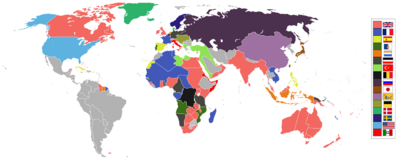
After Europeans had achieved influence and control over the Americas, imperial activities turned to the lands of Asia and Oceania. In the 19th century the European states had social and technological advantage over Eastern lands.[citation needed] Britain gained control of the Indian subcontinent, Egypt and the Malay Peninsula; the French took Indochina; while the Dutch cemented their control over the Dutch East Indies. The British also colonized Australia, New Zealand and South Africa with large numbers of British colonists emigrating to these colonies. Russia colonized large pre-agricultural areas of Siberia. In the late 19th century, the European powers divided the remaining areas of Africa. Within Europe, economic and military challenges created a system of nation states, and ethno-linguistic groupings began to identify themselves as distinctive nations with aspirations for cultural and political autonomy. This nationalism would become important to peoples across the world in the 20th century.
During the Second Industrial Revolution, the world economy became reliant on coal as a fuel, as new methods of transport, such as railways and steamships, effectively shrank the world. Meanwhile, industrial pollution and environmental damage, present since the discovery of fire and the beginning of civilization, accelerated drastically.
The advantages that Europe had developed by the mid-18th century were two: an entrepreneurial culture,[128] and the wealth generated by the Atlantic trade (including the African slave trade). By the late 16th century, silver from the Americas accounted for the Spanish empire's wealth.[citation needed] The profits of the slave trade and of West Indian plantations amounted to 5% of the British economy at the time of the Industrial Revolution.[129] While some historians conclude that, in 1750, labour productivity in the most developed regions of China was still on a par with that of Europe's Atlantic economy,[130] other historians such as Angus Maddison hold that the per-capita productivity of western Europe had by the late Middle Ages surpassed that of all other regions.[131]
1914–1945
The 20th century opened with Europe at an apex of wealth and power, and with much of the world under its direct colonial control or its indirect domination. Much of the rest of the world was influenced by heavily Europeanized nations: the United States and Japan.
As the century unfolded, however, the global system dominated by rival powers was subjected to severe strains, and ultimately yielded to a more fluid structure of independent nations organized on Western models.
This transformation was catalyzed by wars of unparalleled scope and devastation. World War I led to the collapse of four empires – Austria-Hungary, the German Empire, the Ottoman Empire, and the Russian Empire – and weakened Great Britain and France .
In the war's aftermath, powerful ideologies rose to prominence. The Russian Revolution of 1917 created the first communist state, while the 1920s and 1930s saw militaristic fascist dictatorships gain control in Italy, Germany, Spain, and elsewhere.
Ongoing national rivalries, exacerbated by the economic turmoil of the Great Depression, helped precipitate World War II. The militaristic dictatorships of Europe and Japan pursued an ultimately doomed course of imperialist expansionism, in the course of which Nazi Germany orchestrated the murder of six million Jews in the Holocaust and of millions of Poles, Russians, and other Slavs, while Imperial Japan murdered millions of Chinese. An earlier model of genocide had been provided by Turkey's World War I mass murder of Armenians.
The World War II defeat of the Axis Powers opened the way for the advance of communism into Central Europe, Yugoslavia, Bulgaria, Romania, Albania, China , North Vietnam, and North Korea.
Contemporary history
1945–2000
When World War II ended in 1945, the United Nations was founded in the hope of preventing future wars,[132][lower-alpha 5] as the League of Nations had been formed following World War I.[134] The war had left two countries, the United States and the Soviet Union, with principal power to influence international affairs.[135] Each was suspicious of the other and feared a global spread of the other's, respectively capitalist and communist, political-economic model. This led to the Cold War, a forty-five-year stand-off and arms race between the United States and its allies, on one hand, and the Soviet Union and its allies on the other.[136]
With the development of nuclear weapons during World War II, and with their subsequent proliferation, all of humanity were put at risk of nuclear war between the two superpowers, as demonstrated by many incidents, most prominently the October 1962 Cuban Missile Crisis. Such war being viewed as impractical, the superpowers instead waged proxy wars in non-nuclear-armed Third World countries.[137]
In China, Mao Zedong implemented industrialization and collectivization reforms as part of the Great Leap Forward (1958–1962), leading to the starvation deaths (1959–1961) of tens of millions of people.
Between 1969 and 1972, as part of the Cold War space race, twelve men were landed on the Moon and safely returned to Earth.[lower-alpha 6]
The Cold War ended in 1991, when the Soviet Union disintegrated, in part due to inability to compete economically with the United States and western Europe. However, the United States likewise began to show signs of slippage in its geopolitical influence,[139][lower-alpha 7] even as its private sector, now less inhibited by the claims of the public sector, increasingly sought private advantage to the prejudice of the public weal.[lower-alpha 8][lower-alpha 9][lower-alpha 10]
In the early postwar decades, the colonies in Asia and Africa of the Belgian, British, Dutch, French, and other west European empires won their formal independence.[144] But the newly independent countries faced challenges in the form of neocolonialism, sociopolitical disarray, poverty, illiteracy, and endemic tropical diseases.[145][lower-alpha 11][lower-alpha 12]
Most Western European and Central European countries gradually formed a political and economic community, the European Union, which expanded eastward to include former Soviet-satellite countries.[148][149][150] The European Union's effectiveness was handicapped by the immaturity of its common economic and political institutions,[lower-alpha 13] somewhat comparable to the inadequacy of United States institutions under the Articles of Confederation prior to the adoption of the U.S. Constitution that came into force in 1789. Asian, African, and South American countries followed suit and began taking tentative steps toward forming their own respective continental associations.

Cold War preparations to deter or to fight a third world war accelerated advances in technologies that, though conceptualized before World War II, had been implemented for that war's exigencies, such as jet aircraft, rocketry, and electronic computers. In the decades after World War II, these advances led to jet travel, artificial satellites with innumerable applications including global positioning systems (GPS), and the Internet—inventions that have revolutionized the movement of people, ideas, and information.
However, not all scientific and technological advances in the second half of the 20th century required an initial military impetus. That period also saw ground-breaking developments such as the discovery of the structure of DNA,[152] the consequent sequencing of the human genome, the worldwide eradication of smallpox, the discovery of plate tectonics, manned and unmanned exploration of space and of previously inaccessible parts of Earth, and foundational discoveries in physics phenomena ranging from the smallest entities (particle physics) to the greatest entity (physical cosmology).
The century saw many global threats emerge or become more serious or more widely recognized, including nuclear-weapons proliferation,[lower-alpha 14][lower-alpha 15][155] nuclear-war close calls, nuclear power-plant accidents, global climate change,[156][157][158] air pollution,[lower-alpha 16] chemical pollution, deforestation, desertification of arable land, ocean acidification[lower-alpha 17] and pollution, mass extinctions of plants and animals, overpopulation, deadly epidemics of microbial and viral diseases,[lower-alpha 18] near-Earth asteroids and comets,[162] supervolcano eruptions, lethal gamma-ray bursts, geomagnetic storms,[163] and the dwindling of natural resources worldwide.[164]
21st century
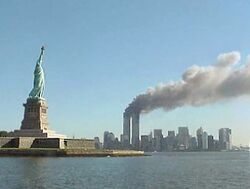
The 21st century has been marked by growing economic globalization and integration, with consequent increased risk to interlinked economies, as exemplified by the Great Recession of the late 2000s and early 2010s.[165] This period has also seen the expansion of communications with mobile phones and the Internet, which have caused fundamental societal changes in business, politics, and individuals' personal lives. The Internet and mobile telephony have also expanded the space for criminal behaviour on the part of individuals, organizations, corporations, and rogue states.[166][lower-alpha 19]
The early 21st century saw escalating intra- and international strife in the Near East and Afghanistan, stimulated by vast economic disparities, by dissatisfaction with governments dominated by Western interests, by inter-ethnic and inter-sectarian feuds, and by the longest war in the history of the United States, the proximate cause for which was Osama bin Laden's provocative 2001 destruction of New York City 's World Trade Center.[lower-alpha 20] The Arab Spring, a revolutionary wave of uprisings in North Africa and the Near East in the early 2010s, produced power vacuums that led to a resurgence of authoritarianism and the advent of reactionary groups like the Islamic State.
U.S. military involvements in the Near East and Afghanistan,[lower-alpha 21] along with a financial crisis and resultant recession, have drained U.S. economic resources at a time when the U.S. and other Western countries are experiencing mounting socioeconomic dislocations aggravated by the robotization of work and the export of industries to cheaper-workforce countries.[lower-alpha 22][lower-alpha 23][lower-alpha 24][lower-alpha 25][lower-alpha 26] Meanwhile, ancient and populous Asian civilizations – India and especially China – have been emerging from centuries of relative scientific, technological, and economic dormancy to become potential economic and political rivals for Western powers.[175]
Worldwide competition for resources has risen due to growing populations and industrialization, especially in India, China, and Brazil.[lower-alpha 27] The increased demands are contributing to increased environmental degradation and to global warming, with resultant intensification of tropical cyclones, floods, droughts,[lower-alpha 28] forest fires, and incidence of hyperthermia deaths.
Such disasters, and a need for safe, reliable energy supplies independent of politically volatile regions, has spurred the development of renewable sources of energy, chiefly solar and wind energy, in place of the "fissile-fossil complex"[177] of nuclear energy and carbon-based energy (petroleum, coal, natural gas).[178][179] In recognition of the existential threat posed by climate change,[lower-alpha 29][lower-alpha 30][182][lower-alpha 31] in December 2015 195 countries signed the Paris Climate Agreement, though in 2017 President Donald Trump announced his withdrawal of the United States from the Agreement.[184][lower-alpha 32][lower-alpha 33][lower-alpha 34][lower-alpha 35][189][lower-alpha 36][190][lower-alpha 37]
International tensions were heightened in connection with the efforts of some nuclear-armed states to induce North Korea to give up its nuclear weapons, and to prevent Iran from developing nuclear weapons.[192][lower-alpha 38]
See also
- Andrew Marr's History of the World (BBC)
- Cultural history
- Economic history of the world
- Historic recurrence
- Historiography
- History of science
- History of technology
- List of archeological periods
- List of millennia
- List of time periods
- Timeline of historical geopolitical changes
References
Explanatory notes
- ↑ The very word "civilization" comes from the Latin civilis, meaning "civil," related to civis ("citizen") and civitas ("city" or "city-state").[44]
- ↑ However, the Green Revolution has brought unintended consequences: "India originally possessed some 110,000 landraces of rice with diverse and valuable properties. These include enrichment in vital nutrients and the ability to withstand flood, drought, salinity or pest infestations. The Green Revolution covered fields with a few high-yielding varieties, so that roughly 90 percent of the landraces vanished from farmers' collections. High-yielding varieties require expensive inputs. They perform abysmally on marginal farms or in adverse environmental conditions, forcing poor farmers into debt."[118]
- ↑ "Early Modern," historically speaking, refers to Western European history from 1501 (after the widely accepted end of the Late Middle Ages; the transition period was the 15th century) to either 1750 or c. 1790–1800, by whichever epoch is favoured by a school of scholars defining the period—which, in many cases of periodization, differs as well within a discipline such as art, philosophy or history.
- ↑ The Age of Enlightenment has also been referred to as the Age of Reason. Historians also include the late 17th century, which is typically known as the Age of Reason or Age of Rationalism, as part of the Enlightenment; however, contemporary historians have considered the Age of Reason distinct to the ideas developed in the Enlightenment. The use of the term here includes both Ages under a single all-inclusive time-frame.
- ↑ Historian Samuel Zipp writes that "the Allies had no plan – during [World War II] – for a new world body to replace the League of Nations. Here Wendell Willkie distinguish[ed] himself from [Franklin D.] Roosevelt, who favored a limited procedural role for most countries in what would become the United Nations . Smaller nations could "blow off steam" in a legislative assembly, Roosevelt... commented, while the "Four Policemen" – the United States, Britain, the Soviet Union, and China – would run things from an executive body. Willkie [advocated for] a more egalitarian international body with the power to curb national sovereignty, not just a debating society run by the great powers.... Roosevelt's vision won out. The United Nations was shaped to fit American, British, and Soviet strategic demands. The members of the Security Council, as the executive body came to be called after France was added to the ranks of FDR's policemen, enjoyed a veto over any initiatives that endangered their interests. Smaller nations looked on from the General Assembly, while the UN had no international police powers that might infringe upon national sovereignty. It would oversee the gradual progress of some colonies toward self-determination, but many others would be left to the whims of their prewar masters. The United States helped establish a multilateral "rules based order" designed to contain communism and allow the European powers to fortify their colonial holdings – a decision that would end in tears in Vietnam."[133]
- ↑ James Gleick writes in The New York Review of Books: "'If we can put a man on the moon, why can's we...?' became a cliché even before [the] Apollo [program] succeeded.... Now... the missing predicate is the urgent one: why can't we stop destroying the climate of our own planet?... I say leave it [the moon] alone for a while."[138]
- ↑ "In the aftermath of the disintegration of the Soviet Union..." writes Graham Allison, "Americans were... caught up in a surge of triumphalism." Francis Fukuyama, in a 1992 best-selling book, proclaimed The End of History, the victory of free-market economics, and the permanent ascendancy of Western liberal democracy. But it soon became evident, writes Allison, that "the end of the Cold War [had] produced a unipolar moment, not a unipolar era. [T]he U.S. economy, which [had] accounted for half of the world's GDP after World War II, had fallen to less than a quarter of global GDP by the end of the Cold War and stands at just one-seventh today. For a nation whose core strategy has been to overwhelm challenges with resources, this decline calls into question the terms of U.S. leadership."[140]
- ↑ "In the advanced economies of the West, from 1945 to around 1975," writes Robin Varghese in Foreign Affairs, "voters showed how politics could tame markets, putting officials in power who pursued a range of social democratic policies without damaging the economy. This period... saw a historically unique combination of high growth, increasing productivity, rising real wages, technological innovation, and expanding systems of social insurance in Western Europe, North America, and Japan .... Since the 1970s, businesses across the developed world have been cutting their wage bills not only through labor-saving technological innovations but also by pushing for regulatory changes and developing new forms of employment. These include just-in-time contracts, which shift risks to workers; noncompete clauses, which reduce bargaining power; and freelance arrangements, which exempt businesses from providing employees with benefits such as health insurance. The result has been that since the beginning of the twenty-first century, labor's share of GDP has fallen steadily in many developed economies.... The challenge today is to identify... a mixed economy that can successfully deliver what the [1945–75] golden age did, this time with greater gender and racial equality to boot."[141]
- ↑ Historian Christopher R. Browning writes: "In the first three postwar decades, workers and management effectively shared the increased wealth produced by the growth in productivity. Since the 1970s that social contract has collapsed, union membership and influence have declined, wage growth has stagnated, and inequality in wealth has grown sharply."[142]
- ↑ Economics Nobel laureate Joseph E. Stiglitz writes in Scientific American, in part: "[T]he U.S. has the highest level of economic inequality among developed countries.... Since the mid-1970s the rules of the economic game have been rewritten... globally and nationally [to] advantage the rich... in a political system that is itself rigged through gerrymandering, voter suppression and the influence of money.... [Enforcement of] antitrust laws, first enacted [in 1890] in the U.S. to prevent the agglomeration of market power, has weakened... Technological changes have concentrated market power in the hands of a few global players... part[ly] because of "network effects"... [E]stablished firms with deep war chests have enormous power to crush competitors and ultimately raise prices.... A concerted attack on unions has almost halved the fraction of unionized workers in the [U.S.], to about 11 percent.... U.S. investment treaties such as NAFTA protect investors against a tightening of environmental and health regulations abroad. [Such] provisions... enhance the credibility of a company's threat to move abroad if workers do not temper their demands.... [I]t is hard to imagine meaningful change without a concerted effort to take money out of politics..."[143]
- ↑ The president of the World Bank, Jim Yong Kim, urges the governments of both developed and developing countries to invest more in human capital, "which is the sum total of a population's health, skills, knowledge, experience, and habits." Increased levels of quality education increase a person's income. "Socioemotional skills, such as grit and conscientiousness, often have equally large economic returns.... Health also matters. [I]n Kenya, [administration of inexpensive] deworming drugs in childhood [has] reduced school absences and raised wages in adulthood by... 20 percent... Proper nutrition and stimulation in utero and during early childhood improve physical and mental well-being later in life. [F]ocusing on human capital during the first 1,000 days of a child's life is one of the most cost-effective investments governments can make.... Human capital doesn't materialize on its own; it must be nurtured by the state."[146]
- ↑ William Hardy McNeill, in his 1963 book The Rise of the West, appears to have interpreted the decline of the European empires as paradoxically being due to Westernization itself, writing that "Although European empires have decayed since 1945, and the separate nation-states of Europe have been eclipsed as centers of political power by the melding of peoples and nations occurring under the aegis of both the American and Russian governments, it remains true that, since the end of World War II, the scramble to imitate and appropriate science, technology, and other aspects of Western culture has accelerated enormously all round the world. Thus the dethronement of western Europe from its brief mastery of the globe coincided with (and was caused by) an unprecedented, rapid Westernization of all the peoples of the earth."[147]:566 McNeill further writes that "The rise of the West, as intended by the title and meaning of this book, is only accelerated when one or another Asian or African people throws off European administration by making Western techniques, attitudes, and ideas sufficiently their own to permit them to do so".[147]:807
- ↑ James McAuley writes in The New York Review of Books, 15 August 2019, pp. 47–48: "There was never a single moment that marked the definitive establishment of the European Union, which... has continued to define itself since World War II. [T]he major turning points have all been quiet steps on the way to further economic integration while preserving national sovereignty. Today there is only an incomplete monetary union without a real political contract to manage it... [Nevertheless, the Union's] various peoples have grown remarkably closer... The European Union now has open borders, a single market from Portugal to the Baltics, and more or less monthly meetings of member state leaders [the European Council]. What's more, those member states are now closer to each other than they are to the United States ... [T]his transformation has occurred informally and organically... [R]obust supranational politics are taking root in Europe... Luuk van Middelaar writes: '[W]hat unites us as Europeans on this continent is bigger and stronger than anything that divides us.'"[151]
- ↑ Former U.S. Secretary of Energy Ernest Moniz and former U.S. Senator Sam Nunn write in Foreign Affairs that "the old [strategic] equilibrium" between the United States and Russia has been "destabilized" by "clashing national interests, insufficient dialogue, eroding arms control structures, advanced missile systems, and new cyberweapons... Unless Washington and Moscow confront these problems now, a major international conflict or nuclear escalation is disturbingly plausible – perhaps even likely."[153]
- ↑ "Nuclear-armed missiles are a political problem that technology cannot solve.... Current U.S. missile defence plans are being driven largely by technology, politics and fear. Missile defences will not allow us to escape our vulnerability to nuclear weapons. Instead large-scale developments will create barriers to taking real steps toward reducing nuclear risks—by blocking further cuts in nuclear arsenals and potentially spurring new deployments."[154]
- ↑ "Today, 91 percent of people worldwide live in areas where air pollution levels exceed the World Health Organization's recommended limits.... [T]here is no safe level of exposure to fine particulate matter.... Most of these fine particles are a by-product of... burning... coal, gasoline, diesel, wood, trash... These particles can get past the defences of our upper airways to penetrate deep into our lungs and reach the alveoli... From there, they cross into the bloodstream and spread throughout the body. They can travel through the nose, up the olfactory nerve, and lodge... in the brain. They can form deposits on the lining of arteries, constricting blood vessels and raising the likelihood of... strokes and heart attacks. [T]hey exacerbate respiratory illnesses like asthma and chronic obstructive pulmonary disease... There's... evidence linking air pollution exposure to an increased risk of Alzheimer's and other forms of dementia."[159]
- ↑ "Absorption of [carbon dioxide] has already made the ocean 30 percent more acidic, with [the acidity] expected to [rise] 'well beyond what fish and other marine organisms can tolerate' by the end of the century..."[160]
- ↑ "[H]istorian Timothy C. Winegard... estimates that mosquitoes have killed more people than any other single cause – fifty-two billion of us, nearly half of all humans who have ever lived.... Globalization is helping to spread a new generation of mosquito-borne illnesses once confined to the tropics, such as dengue... chikungunya and Zika... Meanwhile, climate change is... expanding the ranges in which mosquitoes and the diseases they carry can thrive."[161]
- ↑ The multifarious abuses perpetrated by individuals, organizations, corporations, and governments, using the Internet and mobile telephony, prompt Adrian Chen to muse whether "a technical complex born... of Cold War militarism and mainstreamed in a free-market frenzy might not be fundamentally always at odds with human flourishing."[167]
- ↑ In consequence, write Robert Malley and Jon Finer in Foreign Affairs, "The United States has become captive to a national security paradigm that ends up magnifying the very fears from which it was born.... One possible explanation for the resilience of the terrorist threat is that an overly militarized approach aggravates the very conditions on which terrorist recruitment thrives. The destruction of entire cities and the unintentional killing of civilians, in addition to being tragic, serve as powerful propaganda tools for jihadists. Such incidents feed resentment, grievances, and anti-Americanism."[168]
- ↑ Andrew J. Bacevich urges "a fundamental reassessment of US national-security policy in those parts of the Islamic world [at a time when US] political elites... manifest... indifference to endless war [and when] American wars continue as if on autopilot." The public, writes Bacevich, needs to be informed that "the national security of the United States may not require... stationing... US troops in [over] 170 countries around the world, a massive military budget... or the continuous dropping of ordnance on targets in distant lands of marginal or nonexistent relevance to [the US's] well-being."[169]
- ↑ Shlomo Ben-Ami writes that "the West is beset by deep social inequalities, reinforced in recent decades by poorly managed globalization." He urges the necessity of [g]iving a humane face to the embrace of globalization and innovation..."[170]
- ↑ Liaquat Ahamed writes in The New Yorker, 2 September 2019, p. 28: "As the world economy opened up in the nineteen-eighties, newly mobile capital tended to flow to places that offered the highest return, and very often these were countries with the lowest taxes and the least onerous regulation. To hold on to capital, countries found themselves forced to match the free-market policies of their trading partners. [T]his shift, in turn, led to more uneven income distributions. Countries with larger tax cuts experienced bigger increases in inequality."[171]
- ↑ The socioeconomic dislocations have prompted, in several countries, proposals for, and experiments with, citizens' guaranteed basic incomes, which had been proposed already in Sir Thomas More's Utopia (1516)[172] and in Thomas Paine's Agrarian Justice (1797). The proposals' purposes and prospects are discussed by Benjamin M. Friedman in The New York Review of Books.[173]
- ↑ Nathan Heller writes that a Universal Basic Income in the United States, of perhaps $1,000 a month per individual, would automatically provide a modest social safety net for everyone who could become redundant in the job market due to automation or job exportation – without the current cumbersome, often demeaning bureaucratic mechanisms for means testing and beneficiary supervision. UBI would create, for many persons, life choices not now available to them, and might reduce criminality spawned by desperate living conditions. UBI's supporters have included politicians across the political spectrum such as Daniel Patrick Moynihan, Richard Nixon, George H.W. Bush, Donald Rumsfeld, and Dick Cheney.[174]
- ↑ Liaquat Ahamed writes in The New Yorker, 2 September 2019, p. 28: "[T]here seems to [be] some sort of cap on inequality – a limit to the economic divisions a country can ultimately cope with."[171]
- ↑ See List of countries by carbon dioxide emissions per capita.
- ↑ "[I]n 1951 the average Indian [inhabitant of India] had access annually to 5,200 cubic meters of water. The figure today is 1,400... and will probably fall below 1,000 cubic meters – the UN's definition of 'water scarcity' – at some point in the next few decades. Compounding the problem of lower summer rainfall... India's water table is in freefall [due] to an increase in the number of tube wells... Other contributors to India's seasonal dearth of water are canal leaks [and] the continued sowing of thirsty crops..."[176]
- ↑ The threats caused by the greenhouse effect and global warming, their remedies, and the broader, growing matergetic crisis facing Earth were fairly comprehensively discussed in the December 1970 Scientific American "Biosphere" issue.[180]
- ↑ The "greenhouse effect", substantially responsible for Earth's global warming, was first described in 1824 by the French mathematician Joseph Fourier. The greenhouse effect is a natural mechanism that becomes dangerous if the atmosphere's greenhouse-gas concentrations exceed environmentally safe levels, as they have gradually been doing since the start of the Industrial Revolution. As predicted, this is already increasing the frequency and severity of floods and droughts due to accelerated melting of icecaps, glaciers, and snowpacks; flooding of low-lying coasts; storms; agricultural disruption and famines; ecological displacements; ocean acidification with havoc to marine life; release, from thawing Arctic permafrost, of methane, a greenhouse gas more powerful than carbon dioxide; and intra- and intersocietal conflicts, with increased crime and warfare. The multifarious, irreversible damage from global warming will accelerate as environmental tipping points are reached. The late physicist–cosmologist Stephen Hawking on 2 July 2017, belatedly celebrating his 75th birthday, warned that planet Earth is rapidly approaching an irreversible tipping point that will leave the planet with an uninhabitable environment like that of Venus, with a temperature of 250 degrees and sulphuric-acid rain.[181] The U.S. military are already forced to factor global-warming effects into their planning for military infrastructure, war, and disaster relief.
- ↑ Alan Weisman writes in The New York Review of Books: "[Economic] growth is how we measure economic health, and growth must be... fueled. Other than nuclear energy... no form of energy is so concentrated, and none so cheap or portable, as carbon. By exhuming hundreds of millions of years' worth of buried organic matter and burning it in a couple of centuries, we built our dazzling civilization, not noticing that its wastes were amassing overhead. Now we're finally paying attention, because hell is starting to rain down.... Norman Borlaug [1970 Nobel Peace Prize laureate for his Green Revolution] [f]or the rest of his life... campaigned, in vain, for universal family planning.... One million species are now at risk of extinction, the [U.N.] Intergovernmental Science-Policy Platform on Biodiversity and Ecosystem Services reported [in May 2019].... [B]y 2100 the oceans may be too hot for phytoplankton to photosynthesize.... Phytoplankton... provide, as [Bill] McKibben notes, 'two-thirds of the earth's oxygen.' Their loss... 'would likely result in the mass mortality of animals and humans.'... [In addition, a]bsorption of [carbon dioxide] has already made the ocean 30 percent more acidic, with [the acidity] expected to [rise] 'well beyond what fish and other marine organisms can tolerate' by the end of the century.... Major cities... have come within mere days of running out of water... McKibben [writes of] the duplicity of oil companies: 'There should be a word for when you commit treason against an entire planet.' As early as 1977, one of Exxon's own scientists [told] the company's executives that their products were causing a greenhouse effect, and that there would be only 'five to ten years before... hard decisions [on] changes in energy strategies might become critical.'" (pp. 4,6.)[183]
- ↑ On 8 October 2018 the Intergovernmental Panel on Climate Change published a Special Report on Global Warming of 1.5 °C stating that, if drastic changes in the global energy base and lifestyle are not made by about 2030—within a dozen years—civilization on planet Earth will become unsalvageable.[185]
- ↑ Astrophysicist John Gribbin, writing in Scientific American, contemplates the evolution of the cosmic infrastructure that made the history of the world possible, and concludes that "we are probably the only intelligent life in the Milky Way galaxy.... And if our planet is so special, it becomes all the more important to preserve this unique world for ourselves, our descendants and the many creatures that call Earth home." He explains that the universe's first stars after the Big Bang, 13 billion years ago, could not have had planets because chemical elements heavier than hydrogen and helium had not yet been cooked up inside stars. By the time our star, the Sun, came into being 4.5 billion years ago, there were sufficient amounts of heavier elements available to form Earth. The Sun resides within a fairly narrow "galactic habitable zone" that is at reduced risk from destructive supernovae and gamma-ray bursts. An orderly arrangement of planets in nearly circular orbits providing long-term stability – as in our solar system – is uncommon. "Earth-like planets" that have been discovered are generally uninhabitable, by contrast with Earth with its thin mobile crust where tectonic activity brings ores and nutrients to the surface through volcanism. Earth also has a large metallic core that, coupled with Earth's rapid rotation, produces a strong magnetic field that shields Earth from harmful cosmic radiation; without this screen, "our atomosphere would probably erode, and any living thing on the surface would get fried." These planetary attributes are diredtly related to our Moon, which probably formed early in the solar system's history when a Mars-size object struck the nascent Earth a glancing blow, causing both protoplanets to melt; the metallic material from the two objects settled into Earth's center, and much of Earth's original lighter rocky material splashed out to become the Moon, leaving Earth with a thinner crust. Without that impact, Earth would lack its crucial magnetic field and plate tectonics. The presence of such a large Moon stabilizes Earth, preventing it from toppling far from the vertical, as happened with Mars. Once the Earth-Moon system settled down, "life emerged with almost indecent rapidity": fossils of single-celled prokaryotes have been found in rocks 3.4 billion years old – about a billion years younger than Earth. But it was only about 1.5 billion years ago that more complex, eukaryote cells, the stuff of all plants and animals, arose from a single merging of two types of primordial single-celled organisms: bacteria and archaea. "It is a measure of how unlikely such a single fusion of cells was that it took two billion years of evolution to occur." Even then, little changed for about a billion years, apart from early eukaryotes forming flat, soft-bodied multicellular organisms, until the Cambrian explosion some 550 million years ago. DNA analysis, showing extremely close similarities among the most diverse human populations, indicates that all humans are descended from a tiny population, possibly survivors of some catastrophe or catastrophes. DNA evidence pinpoints two evolutionary bottlenecks: 150,000 years ago, the human population was reduced to no more than a few thousand breeding pairs; and about 70,000 years ago, the entire human population fell to about 1,000. "Is life likely to exist elsewhere in the galaxy?" asks John Gribbin. "Almost certainly, given the speed with which it appeared on Earth. Is another technological civilization likely to exist today? Almost certainly no, given the chain of circumstances that led to our existence."[186]
- ↑ Historian Christopher R. Browning concludes an article on "The Suffocation of Democracy": "[W]ithin several decades after Trump's presidency has ended, the looming effects of ecological disaster due to human-caused climate change—which Trump not only denies but is doing so much to accelerate—will be inescapable. Desertification of continental interiors, flooding of populous coastal areas, and increased frequency and intensity of extreme weather events, with concomitant shortages of fresh water and food, will set in motion both population flight and conflicts over scarce resources that dwarf the current fate of Central Africa and Syria. No wall will be high enough to shelter the US from these events....".[187]
- ↑ Environmentalist Bill McKibben explains that the 2018 IPCC Special Report understates the climatic perils to Earth and adds: "[E]ngineers have [made] remarkable advances, and the price of [electrical energy] generated by the sun or wind has continued to plunge... these are now the cheapest sources of power across much of the globe. Battery storage technology has progressed too; the fact that the sun goes down at night is no longer the obstacle to solar power many once presumed.... California , the planet's fifth-largest economy, promise[s] to be carbon-neutral by 2045.... [The] paramount reason we didn't heed... earlier warnings [is] the power of the fossil fuel industry.... [But] the relentless floods and storms and fires have gotten Americans' attention... 93 percent of Democrats want more solar farms; so do 84 percent of Republicans.... In October [2017] the [New York State] attorney general...filed suit against Exxon-Mobil, claiming the company defrauded shareholders by downplaying the risks of climate change. In January [2018] New York City joined the growing fossil fuel divestment campaign... Mayor Bill de Blasio is working with London's mayor, Sadiq Khan, to convince their colleagues around the world to do likewise. In July [2018] Ireland became the first nation to join the campaign... This kind of pressure on [fossil-fuel] investors needs to continue..."[188]
- ↑ The U.S. Government’s Fourth National Climate Assessment, released on 23 November 2018, describes the horrific prospects for the “U.S. economy, human health, and the environment” if emissions of greenhouse gases are not curtailed substantially on an urgent basis.
- ↑ Bill McKibben sees encouraging signs of progress in the worldwide campaign to replace the fissile-fossil complex with solar energy, direct and indirect (wind power). "Over the last decade, there has been a staggering fall in the price of solar and wind power, and of the lithium-ion batteries used to store energy.... Who is going to invest in [a fossil-fuel] industry that is clearly destined to shrink?... [Petroleum's] price should fall if it has to compete with the price of sunshine.... [T]he world's largest private-sector coal-mining company, [Peabody, went from the Fortune 500 list of most prosperous U.S. corporations] to bankrupt[cy] in 2016.... [O]ver the first nine months of 2018, India installed forty times more capacity for renewable than for coal-fired power.... Even "cheap" natural gas is... starting to look expensive compared to... sun, wind, and batteries.... [Once-powerful] General Electric [has become] "a thermal-power-reliant basket case" [and in 2018] was dropped from the Dow Industrial Index... The world's leading car companies have become convinced that electric vehicles will account for all the growth in demand by the early 2020s.... An effort... launch[ed] in 2012 to persuade universities and churches to divest their fossil fuel shares has... become the largest divestment campaign in history.... Countries in Africa and South Asia have a[n] opportunity to avoid expensive fixed investments in fossil fuels and centralized grids by adopting mini-grids and decentralized solar and wind energy deployed off-grid – just as they jumped straight to mobile phones and obviated the need to lay expensive copper-wired telephone networks.... Imagine a world in which the tortured politics of the Middle East weren't magnified in importance by the value of the hydrocarbons beneath its sands.... The question, of course, is whether we can reach that new world in time."[191]
- ↑ Historian Christopher Clark writes: "The quest for peace, like the struggle to arrest climate change, requires that we think of ourselves not just as states, tribes, or nations, but as the human inhabitants of a shared space."[193]
- Citations
- ↑ "International Programs - Historical Estimates of World Population - U.S. Census Bureau". United States Census Bureau. August 2016. https://www.census.gov/population/international/data/worldpop/table_history.php. Retrieved 15 November 2016.
- ↑ Tudge 1998, pp. 30–31.
- ↑ McNeill 1999, pp. 13–15.
- ↑ Baines & Malek 2000, p. 8.
- ↑ 5.0 5.1 Bard 2000, pp. 64–65.
- ↑ Chakrabarti 2004, p. 11.
- ↑ 7.0 7.1 Lee 2002, pp. 15–42.
- ↑ 8.0 8.1 Teeple 2006, pp. 14–20.
- ↑ Roberts & Westad 2013, p. 161.
- ↑ Stearns & Langer 2001, p. 12.
- ↑ 11.0 11.1 Stearns & Langer 2001, p. 14.
- ↑ Hart-Davis 2012, p. 63.
- ↑ Grant 2006, p. 53.
- ↑ Roberts & Westad 2013, p. 535.
- ↑ 15.0 15.1 15.2 Bentley & Ziegler 2008, p. 595.
- ↑ Roberts & Westad 2013, pp. 712–14.
- ↑ Baten 2016, pp. 1–13.
- ↑ Chen & Li 2001, pp. 444–56.
- ↑ "Homo sapiens". The Smithsonian Institutions's Human Origins Program. Smithsonian Institution. 8 February 2016. http://humanorigins.si.edu/evidence/human-fossils/species/homo-sapiens. Retrieved 21 May 2017.
- ↑ Klein, Richard G. (June 1995). "Anatomy, Behavior, and Modern Human Origins". Journal of World Prehistory 9 (2): 167–98. doi:10.1007/BF02221838. ISSN 0892-7537.
- ↑ Stringer, C. (2012). "Evolution: What Makes a Modern Human". Nature 485 (7396): 33–35. doi:10.1038/485033a. PMID 22552077. Bibcode: 2012Natur.485...33S.
- ↑ Hart-Davis 2012, pp. 24–29.
- ↑ Hart-Davis 2012, p. 17.
- ↑ Hart-Davis 2012, pp. 20–21.
- ↑ Hart-Davis 2012, pp. 32–33.
- ↑ Hart-Davis 2012, pp. 30–31.
- ↑ Gavashelishvili, Alexander; Tarkhnishvili, David (2016). "Biomes and human distribution during the last ice age". Global Ecology and Biogeography 25 (5): 563–74. doi:10.1111/geb.12437.
- ↑ 28.0 28.1 Hart-Davis 2012, pp. 36–37.
- ↑ McNeill 1999, p. 11.
- ↑ Hart-Davis 2012, pp. 42–43.
- ↑ McNeill 1999, p. 13.
- ↑ Roberts & Westad 2013.
- ↑ Roberts & Westad 2013, p. 53.
- ↑ Hart-Davis 2012, p. 44.
- ↑ Roberts & Westad 2013, p. 59.
- ↑ McNeill 1999, p. 16.
- ↑ McNeill 1999, p. 18.
- ↑ 38.0 38.1 38.2 38.3 38.4 Hart-Davis 2012, pp. 62–63.
- ↑ Hart-Davis 2012, p. 58.
- ↑ McNeill 1999, pp. 18–19.
- ↑ Hart-Davis 2012, pp. 60–61.
- ↑ Roberts & Westad 2013, pp. 34–35.
- ↑ Stearns & Langer 2001, p. 15.
- ↑ Larry E. Sullivan (2009), The SAGE glossary of the social and behavioral sciences , Editions SAGE, p. 73.
- ↑ Stearns & Langer 2001, p. 21.
- ↑ 46.0 46.1 Hart-Davis 2012, pp. 54–55.
- ↑ 47.0 47.1 Chakrabarti 2004, pp. 10–13.
- ↑ Allchin & Allchin 1997, pp. 153–68.
- ↑ Roberts & Westad 2013, pp. 43–46.
- ↑ Mercer 1949, p. 259.
- ↑ Allen 2007, p. 1.
- ↑ Buchanan 1979, p. 23.
- ↑ 53.0 53.1 Roberts & Westad 2013, pp. 53–54.
- ↑ Bard 2000, pp. 57–64.
- ↑ Hart-Davis 2012, pp. 76–77.
- ↑ McNeill 1999, pp. 36–37.
- ↑ Price & Thonemann 2010, p. 22.
- ↑ Roberts & Westad 2013, pp. 116–22.
- ↑ Singh 2008, pp. 260–64.
- ↑ Stearns & Langer 2001, p. 63.
- ↑ Stearns & Langer 2001, pp. 70–71.
- ↑ Roberts & Westad 2013, p. 110.
- ↑ Martin 2000, pp. 106–07.
- ↑ Golden 2011, p. 25.
- ↑ "Alexander the Great". BBC. https://www.bbc.co.uk/history/historic_figures/alexander_the_great.shtml.
- ↑ Hemingway, Collette; Hemingway, Seán (April 2007). "Art of the Hellenistic Age and the Hellenistic Tradition". Metropolitan Museum of Art. http://www.metmuseum.org/toah/hd/haht/hd_haht.htm.
- ↑ Kulke, Hermann; Rothermund, Dietmar (2004). A History of India (4th ed.). Routledge. ISBN 978-0-415-32920-0.
- ↑ Nilakanta Sastri, K. A.. A History of South India. p. 157.
- ↑ Hart-Davis 2012, pp. 106–07.
- ↑ Kelly 2007, pp. 4–6.
- ↑ Zhou, Jinghao (2003). Remaking China's Public Philosophy for the Twenty-First Century. Westport: Greenwood Publishing Group. ISBN 978-0-275-97882-2.
- ↑ Fagan 2005, pp. 390, 396.
- ↑ Zapotec civilization has its beginnings in 700 BCE: see Flannery, Kent V.; Marcus, Joyce (1996). Zapotec Civilization: How Urban Society Evolved in Mexico's Oaxaca Valley. New York: Thames & Hudson. p. 146. ISBN 978-0-500-05078-1. Zapotec civilization ended in 1521 according to the five archaeological stages presented in Whitecotton, Joseph W. (1977). The Zapotecs: Princes, Priests, and Peasants. Norman: University of Oklahoma Press. 26, LI.1–3.
- ↑ Coe 2011, p. 91.
- ↑ Camp, John McK.; Dinsmoor, William B. (1984). Ancient Athenian building methods. Excavations of the Athenian Agora. 21. Princeton, NJ: American School of Classical Studies at Athens. ISBN 978-0-87661-626-0. https://archive.org/details/ancientathenianb00camp.
- ↑ Stearns & Langer 2001, pp. 95, 99.
- ↑ Collins 1999, pp. 80–99.
- ↑ Collins 1999, pp. 100–15.
- ↑ Stearns & Langer 2001, pp. 97, 103.
- ↑ Collins 1999, p. 404.
- ↑ Loyn 1991, pp. 122–23.
- ↑ Whaley, Joachim (2012). Germany and the Holy Roman Empire. 1. pp. 17–20.
- ↑ Johnson 1996, p. 23.
- ↑ "Dynasties of Early Imperial China: Han Dynasty". Minnesota State University. Archived from the original on 10 July 2009. https://web.archive.org/web/20090710041505/http://www.mnsu.edu/emuseum/prehistory/china/early_imperial_china/han.html. Retrieved 18 April 2009.
- ↑ Gascoigne 2003, pp. 90–92.
- ↑ Gernet 1996, pp. 237–38.
- ↑ 87.0 87.1 Shaw 1976, p. 13.
- ↑ 88.0 88.1 Ebrey, Walthall & Palais 2006, p. 113.
- ↑ Xue 1992, pp. 149–52, 257–64.
- ↑ Xue 1992, pp. 226–27.
- ↑ Ṭabīb et al. 2001, p. 9.
- ↑ Stearns & Langer 2001, p. 153.
- ↑ Roesdahl, Else (1998). The Vikings. Penguin Books. ISBN 978-0-14-025282-8. https://archive.org/details/vikingsreviseded00else.
- ↑ Dunham, Will (29 January 2008). "Black death 'discriminated' between victims". ABC Science. http://www.abc.net.au/science/articles/2008/01/29/2149185.htm.
- ↑ "De-coding the Black Death". BBC. 3 October 2001. http://news.bbc.co.uk/2/hi/health/1576875.stm.
- ↑ "Plague: The Black Death". National Geographic. http://science.nationalgeographic.com/science/health-and-human-body/human-diseases/plague-article.html. Retrieved 3 November 2008.
- ↑ Stearns & Langer 2001, p. 280.
- ↑ McNeill 1999, pp. 319–23.
- ↑ McNeill 1999, pp. 267–68.
- ↑ Blier, Suzanne Preston (2012). "Art in Ancient Ife, Birthplace of the Yoruba". African Arts 45 (4): 70–85. doi:10.1162/afar_a_00029. http://scholar.harvard.edu/files/blier/files/blier.pdf. Retrieved 24 November 2016.
- ↑ Lewis 2009, p. 1.
- ↑ Whitfield 2004, p. 193.
- ↑ McNeill 1982, p. 50.
- ↑ Buell, Paul D. (2003). Historical dictionary of the Mongol world empire. Lanham (Maryland): Scarecrow Press. ISBN 978-0-8108-4571-8.
- ↑ Mason, R.H.P.; Caiger, J.G. (2011). A History of Japan (Revised ed.). New York: Tuttle Publishing. ISBN 978-1-4629-0097-8.
- ↑ Dolan, Ronald E., ed (1994). "Nara and Heian Periods, A.D. 710–1185". Japan: A Country Study. Library of Congress, Federal Research Division.
- ↑ Ackerman, Marsha E.; Schroeder, Michael J.; Terry, Janice J. et al., eds (2008). "Three Kingdoms, Korea". Encyclopedia of world history. New York: Facts on File. p. 464. ISBN 978-0-8160-6386-4.
- ↑ "남북국시대 (North-South States Period)". Naver. http://terms.naver.com/entry.nhn?docId=1075074&cid=40942&categoryId=33373.
- ↑ The Association of Korean History Teachers (2005). Korea through the ages; Volume One: Ancient. Seongnam-si: The Center for Information on Korean Culture, The Academy of Korean Studies. p. 113. ISBN 978-89-7105-545-8.
- ↑ Kirch, Patrick Vinton; Green, Roger C. (2001). Hawaiki, ancestral Polynesia: an essay in historical anthropology. Cambridge University press. p. 87. ISBN 978-0-521-78879-3. https://books.google.com/?id=WRapfjQ_iTEC&lpg=PA87&pg=PA87.
- ↑ Geraghty, Paul (1994). "Linguistic evidence for the Tongan empire". in Dutton, Tom. Language contact and change in the Austronesian world. Trends in linguistics: Studies and monographs. 77. Berlin: Gruyter. pp. 236–39. ISBN 978-3-11-012786-7. https://books.google.com/books?id=xOlI8czLshIC&pg=PA233.
- ↑ Fagan 2005, p. 35.
- ↑ Intrinsic to the English language, "modern" denotes (in reference to history) a period that is opposed to either ancient or medieval; modern history is the history of the world since the end of the Middle Ages.
- ↑ "The Century Dictionary and Cyclopedia". 1906. https://books.google.com/books?id=LaNDmZBcNGQC&pg=PA3814.
- ↑ Dunan, Marcel (1964). Larousse Encyclopedia of Modern History, From 1500 to the Present Day. New York: Harper & Row. OCLC 395134.
- ↑ "modern". The American Heritage Dictionary of the English Language (4th ed.). Houghton Mifflin. 2000. http://www.bartleby.com/61/28/M0362800.html. Retrieved 29 November 2019.
- ↑ Baird, F.E., & Kaufmann, W.A. (2008). Philosophic classics: From Plato to Derrida. Upper Saddle River, NJ: Pearson/Prentice Hall.
- ↑ Debal Deb, "Restoring Rice Biodiversity", Scientific American, vol. 321, no. 4 (October 2019), pp. 54–61. (p. 54.)
- ↑ "Islamic Culture and the Medical Arts: Late Medieval and Early Modern Medicine". National Institutes of Health. 15 December 2011. https://www.nlm.nih.gov/exhibition/islamic_medical/islamic_14.html.
- ↑ Hart-Davis 2012, pp. 250–53.
- ↑ Roberts & Westad 2013, pp. 683–85.
- ↑ Imber 2002, p. 66.
- ↑ Ebrey, Walthall & Palais 2006.
- ↑ Stearns & Langer 2001, pp. 376–77.
- ↑ Miller, Edward; Postan, Cynthia; Postan, Michael Moissey, eds (1987). The Cambridge economic history of Europe: Volume 2, Trade and Industry in the Middle Ages (2nd ed.). Cambridge: Cambridge University Press. ISBN 978-0-521-08709-4.
- ↑ La l, Vinay (2001). "The Mughal Empire". Manas: India and its Neighbors. University of California, Los Angeles. https://www.sscnet.ucla.edu/southasia/History/Mughals/mughals.html. Retrieved 12 April 2015.
- ↑ "Fort Ross". Office of Historic Preservation, California State Parks. http://ohp.parks.ca.gov/ListedResources/Detail/5. Retrieved 2018-02-15.
- ↑ Wood, Neal (1984). John Locke and agrarian capitalism. Berkeley: University of California Press. ISBN 978-0-520-05046-4. https://books.google.com/books?id=2KIpqQ9QHBkC&printsec=frontcover.
- ↑ Mintz, S.; McNeil, S.. "Was slavery the engine of economic growth?". Archived from the original on 26 February 2009. https://web.archive.org/web/20090226000000/http://www.digitalhistory.uh.edu/historyonline/con_economic.cfm.
- ↑ see the NBER Publications by Carol H. Shiue and Wolfgang Keller at nber.org
- ↑ "Homepage of Angus Maddison". Ggdc.net. http://www.ggdc.net/maddison/. Retrieved 18 April 2009.
- ↑ Fasulo 2015, pp. 1–3
- ↑ Samuel Zipp, "One World: The lost internationalism of Wendell Willkie" (review of David Levering Lewis, The Improbable Wendell Willkie: The Businessman Who Saved the Republican Party and His Country, and Conceived a New World Order, Norton, 2018, 371 pp.), The Nation, vol. 308, no. 8 (1 April 2019), pp. 32–35.
- ↑ "League of Nations | Definition & Purpose" (in en). Encyclopedia Britannica. https://www.britannica.com/topic/League-of-Nations.
- ↑ Zinn, Howard (2003). A People's History of the United States (5th ed.). New York: HarperPerennial Modern Classics [2005 reprint]. ISBN 978-0-06-083865-2. https://books.google.com/?id=9-FtlblxbLgC&printsec=frontcover.
- ↑ Graham Allison, "The Myth of the Liberal Order: From Historical Accident to Conventional Wisdom", Foreign Affairs, vol. 97, no. 4 (July–August 2018), p. 126.
- ↑ Graham Allison, "The Myth of the Liberal Order: From Historical Accident to Conventional Wisdom", Foreign Affairs, vol. 97, no. 4 (July–August 2018), pp. 127–28.
- ↑ James Gleick, "Moon Fever" [review of Oliver Morton, The Moon: A History of the Future; Apollo's Muse: The Moon in the Age of Photography, an exhibition at the Metropolitan Museum of Art, New York City , 3 July – 22 September 2019; Douglas Brinkley,American Moonshot: John F. Kennedy and the Great Space Race; Brandon R. Brown, The Apollo Chronicles: Engineering America's First Moon Missions; Roger D. Launius, Reaching for the Moon: A Short History of the Space Race; Apollo 11, a documentary film directed by Todd Douglas Miller; and Michael Collins, Carrying the Fire: An Astronaut's Journeys (50th Anniversary Edition)], The New York Review of Books, vol. LXVI, no. 13 (15 August 2019), pp. 54–58. (pp. 57–58.)
- ↑ McCormick 1995, p. 155.
- ↑ Graham Allison, "The Myth of the Liberal Order: From Historical Accident to Conventional Wisdom", Foreign Affairs, vol. 97, no. 4 (July–August 2018), pp. 129–31.
- ↑ Robin Varghese, "Marxist World: What Did You Expect From Capitalism?", Foreign Affairs, vol. 97, no. 4 (July–August 2018), pp. 36–42.
- ↑ Christopher R. Browning, "The Suffocation of Democracy", The New York Review of Books, vol. LXV, no. 16 (25 October 2018), p. 16.
- ↑ Joseph E. Stiglitz, "A Rigged Economy: And what we can do about it" (The Science of Inequality), Scientific American, vol. 319, no. 5 (November 2018), pp. 57–61.
- ↑ Abernethy 2000, p. 133.
- ↑ Stern, Nicholas; Rogers, F. Halsey; Dethier, Jean-Jacques (2006). Growth and Empowerment: Making Development Happen. Munich lectures in economics. Cambridge, Mass: MIT Press. ISBN 978-0-262-26474-7.
- ↑ Jim Yong Kim, "The Human Capital Gap: Getting Governments to Invest in People", Foreign Affairs, vol. 97, no. 4 (July–August 2018), pp. 92–96.
- ↑ 147.0 147.1 McNeill, William H. (1991). The Rise of the West: A History of the Human Community. University of Chicago Press.
- ↑ Dinan, Desmond (2004). Europe recast: a history of European Union. Basingstoke: Palgrave Macmillan. ISBN 978-0-333-98734-6.
- ↑ Peterson, John; Shackleton, Michael, eds (2012). The institutions of the European Union (3rd ed.). Oxford University Press. ISBN 978-0-19-957498-8.
- ↑ Rifkin, Jeremy (2004). The European dream: how Europe's vision of the future is quietly eclipsing the American dream. New York: Jeremy P. Tarcher. ISBN 978-1-58542-345-3. https://archive.org/details/europeandreamhow00rifk.
- ↑ James McAuley, "A More Perfect Union?" (review of Luuk van Middelaar, Alarums and Excursions: Improving Politics on the European Stage, translated from the Dutch by Liz Waters, Agenda, 2019, 301 pp.; and Stéphanie Hennette, Thomas Piketty, Guillaume Sacriste, and Antoine Vauchez, How to Democratize Europe, translated from the French by Paul Dermine, Marc LePain, and Patrick Camiller, Harvard University Press, 2019, 209 pp.), The New York Review of Books, vol. LXVI, no. 13 (15 August 2019), pp. 46–48.
- ↑ Clayton 2016, p. 95.
- ↑ Ernest J. Moniz and Sam Nunn, "The Return of Doomsday: The New Nuclear Arms Race – and How Washington and Moscow Can Stop It", Foreign Affairs, vol. 98, no. 5 (September / October 2019), pp. 150–61. (pp. 151, 161.)
- ↑ Laura Grego and David Wright, "Broken Shield: Missiles designed to destroy incoming nuclear warheads fail frequently in tests and could increase global risk of mass destruction", Scientific American, vol. 320, no. no. 6 (June 2019), pp. 62–67. (p. 67.)
- ↑ Michael T. Klare, "Missile Mania: The death of the INF [Intermediate-Range Nuclear Forces] Treaty [of 1987] has escalated the arms race", The Nation, vol. 309, no. 6 (23 September 2019), p. 4.
- ↑ Mun, Yuri. "Earth Radiation Budget". http://marine.rutgers.edu/cool/education/class/yuri/erb.html.
- ↑ Wood, R.W. (1909). "Note on the Theory of the Greenhouse". Philosophical Magazine 17 (98): 319–20. doi:10.1080/14786440208636602. http://www.wmconnolley.org.uk/sci/wood_rw.1909.html. Retrieved 5 August 2008.
- ↑ Fong, Joss; Caswell, Estelle (22 April 2016). "Why climate change is so important, in one chart". Vox.com. https://www.vox.com/2015/12/12/9894234/climate-change-explained. Retrieved 28 April 2016.
- ↑ Jonathan Mingle, "Our Lethal Air" [review of Gary Fuller, The Invisible Killer...; Beth Gardiner, Choked...; Tim Smedley, Clearing the Air...; U.S. Environmental Protection Agency, Integrated Science Assessment for Particulate Matter (External Review Draft, 2018); and Chartered Clean Air Scientific Advisory Committee, Letter to EPA Administrator on the EPA's Integrated Science Assessment for Particulate Matter, 11 April 2019], The New York Review of Books, vol. LXVI, no. 14 (26 September 2019), pp. 64–66, 68. (p. 64.)
- ↑ Alan Weisman, "Burning Down the House" (review of David Wallace-Wells, The Uninhabitable Earth: Life After Warming, Tim Duggan, 2019, 310 pp.; and Bill McKibben, Falter: Has the Human Game Begun to Play Itself Out?, Henry Holt, 2019, 291 pp.), The New York Review of Books, vol. LXVI, no. 13 (15 August 2019), p. 6.
- ↑ Brooke Jarvis, "Buzz Off: They've ravaged humanity and derailed history. And mosquitoes aren't finished yet", The New Yorker, 5 & 12 August 2019, pp. 69–71.
- ↑ Monastersky, Richard (1 March 1997). "The Call of Catastrophes". Science News Online. https://www.sciencenews.org/archive/call-catastrophes?mode=magazine&context=4378&tgt=nr. Retrieved 23 October 2007.
- ↑ Jonathan O'Callaghan, "Stormy Space Weather: New map reveals the risk of blackouts from geomagnetic storms", Scientific American, vol. 321, no. 2 (August 2019), p. 19.
- ↑ Edwards, Andres R. (2005). The sustainability revolution: portrait of a paradigm shift. Gabriola, B.C.: New Society Publishers. p. 52. ISBN 978-1-55092-325-4.
- ↑ Bob Davis, "What's a Global Recession?", The Wall Street Journal , 22 April 2009. [1] Retrieved 2 January 2019.
- ↑ Richard A. Clarke and Rob Knake, "The Internet Freedom League: How to Push Back against the Authoritarian Assault on the Web", Foreign Affairs, vol. 98, no. 5 (September / October 2019), pp. 184–92.
- ↑ Adrian Chen, "The Confidence Game: How Silicon Valley broke the economy", The Nation, vol. 309, no. 11 (4 November 2019), pp. 27–30. (p. 30.)
- ↑ Robert Malley and Jon Finer, "The Long Shadow of 9/11: How Counterterrorism Warps U.S. Foreign Policy", Foreign Affairs, vol. 97, no. 4 (July–August 2018), pp. 60–67.
- ↑ Andrew J. Bacevich, "Wars without End", The Nation, vol. 307, no. 2 ( 16/23 July 2018), pp. 15–16.
- ↑ Shlomo Ben-Ami, "Gobalization's Discontents", The Nation, vol. 307, no. 2 (16 / 23 July 2018), p. 27.
- ↑ 171.0 171.1 Liaquat Ahamed, "Widening Gyre: The rise and fall and rise of economic inequality", The New Yorker, 2 September 2019, pp. 26–29.
- ↑ Bryce Covert, "What Money Can Buy: The promise of a universal basic income – and its limitations", The Nation, vol. 307, no. 6 (10 / 17 September 2018), p. 33.
- ↑ Benjamin M. Friedman, "Born to Be Free" (review of Philippe Van Parijs and Yannick Vanderborght, Basic Income: A Radical Proposal for a Free Society and a Sane Economy, Harvard University Press, 2017), The New York Review of Books, vol. LXIV, no. 15 (12 October 2017), pp. 39–41.
- ↑ Nathan Heller, "Take the Money and Run: What's behind the enthusiasm for universal basic income?", The New Yorker, 9 & 16 July 2018, pp. 65–69.
- ↑ Paul Kennedy, The Rise and Fall of the Great Powers: Economic Change and Military Conflict from 1500 to 2000, New York, Random House, 1987, ISBN:0-394-54674-1, pp. 242–45, 432, 514–19, 526–29, 533–35, and passim.
- ↑ Christopher de Bellaigue, "The River" (the Ganges; review of Sunil Amrith, Unruly Waters: How Rains, Rivers, Coasts, and Seas Have Shaped Asia's History; Sudipta Sen, Ganges: The Many Pasts of an Indian River; and Victor Mallet, River of Life, River of Death: The Ganges and India's Future), The New York Review of Books, vol. LXVI, no. 15 (10 October 2019), pp.34–36. (p. 35.)
- ↑ Christopher Kasparek, "A Futurological Note: Prus on H.G. Wells and the Year 2000," The Polish Review, vol. XLVIII, no. 1, 2003, pp. 98–99.
- ↑ "Global Trends In Sustainable Energy Investment 2008". UNEP. http://sefi.unep.org/english/globaltrends.
- ↑ "Home Page". http://www.nrel.gov/.
- ↑ The Biosphere (A Scientific American Book), San Francisco, W.H. Freeman and Co., 1970, ISBN:0-7167-0945-7. This seminal book, originally a 1970 Scientific American magazine issue, covered virtually every major concern and concept that has since been discussed regarding materials and energy resources, population trends, and environmental degradation.
- ↑ Stephen Hawking, BBC World Service, 2 July 2017.
- ↑ Jennifer Francis, "Rough Weather Ahead: Recent disasters show how climate change is making winter storms, flooding rains and summer heat waves more extreme", Scientific American, vol. 320, no. 6 (June 2019), pp. 46–53.
- ↑ Alan Weisman, "Burning Down the House" (review of David Wallace-Wells, The Uninhabitable Earth: Life After Warming, Tim Duggan, 2019, 310 pp.; and Bill McKibben, Falter: Has the Human Game Begun to Play Itself Out?, Henry Holt, 2019, 291 pp.), The New York Review of Books, vol. LXVI, no. 13 (15 August 2019), pp. 4, 6, 8.
- ↑ Joshua Busby, "Warming World: Why Climate Change Matters More Than Anything Else", Foreign Affairs, vol. 97, no. 4 (July / August 2018), p. 54.
- ↑ Intergovernmental Panel on Climate Change, Special Report on Global Warming of 1.5 °C, 8 October 2018.
- ↑ John Gribbin, "Alone in the Milky Way: Why we are probably the only intelligent life in the galaxy", Scientific American, vol. 319, no. 3 (September 2018), pp. 94–99.
- ↑ Christopher R. Browning, "The Suffocation of Democracy", The New York Review of Books, vol. LXV, no. 16 (25 October 2018), p. 17.
- ↑ Bill McKibben, "A Very Grim Forecast" (partly a review of Global Warming of 1.5 [degree] C: an IPCC Special Report by the Intergovernmental Panel on Climate Change. Available at www.ipcc.ch), The New York Review of Books, vol. LXV, no. 18 (22 November 2018), pp. 4, 6, 8.
- ↑ Bill McKibben, "Life on a Shrinking Planet: With wildfires, heat waves, and rising sea levels, large tracts of the earth are at risk of becoming uninhabitable", The New Yorker, 26 November 2018, pp. 46–55.
- ↑ Historian Joseph Ellis, speaking at the Free Library of Philadelphia in October 2018 on the publication of his 2018 book, American Dialogue: The Founders and Us (C-SPAN 2 Book TV, re-aired 27 January 2019), said that social reforms tend to occur in the wake of crises: the slavery crisis precipitated the American Civil War; an analogous crisis for our time is that of global warming.
- ↑ Bill McKibben, "A Future without Fossil Fuels?" (review of 2020 Vision: Why You Should See the Fossil Fuel Peak Coming: a report by Kingsmill Bond, 41 pp., September 2018, available at carbontracker.org; and A New World: The Geopolitics of the Energy Transformation: a report by the Global Commission on the Geopolitics of Energy Transformation, 88 pp., January 2019, available at irena.org), The New York Review of Books, vol. LXVI, no. 6 (4 April 2019), pp. 4, 6.
- ↑ Wendy R. Sherman, "How We Got the Iran Deal: And Why We'll Miss It", Foreign Affairs, vol. 97, no. 5 (September / October 2018), pp. 186–97.
- ↑ Christopher Clark, "'This Is a Reality, Not a Threat'" (review of Lawrence Freedman, The Future of War: A History, Public Affairs, 2018, 376 pp.; and Robert H. Latiff, Future War: Preparing for the New Global Battlefield, Knopf, 2018, 192 pp.), The New York Review of Books, vol. LXV, no. 18 (22 November 2018), p. 54.
Bibliography
- Abernethy, David B. (2000). The Dynamics of Global Dominance : European Overseas Empires, 1415–1980. New Haven, CT: Yale University Press. ISBN 978-0-300-09314-8.
- Allchin, Bridget; Allchin, Raymond (1997). Origins of a Civilization: The Prehistory and Early Archaeology of South Asia. New Delhi: Viking. ISBN 978-0-670-87713-3.
- Allen, James P. (2007-08-30). Manuelian, Peter D.. ed. The Ancient Egyptian Pyramid Texts. Society of Biblical Literature. p. 1. ISBN 978-1-58983-678-5.
- Allison, Graham, "The Myth of the Liberal Order: From Historical Accident to Conventional Wisdom", Foreign Affairs, vol. 97, no. 4 (July–August 2018), pp. 124–33.
- Bacevich, Andrew J., "Wars without End", The Nation, vol. 307, no. 2 ( 16/23 July 2018), pp. 15–16.
- Baines, John; Malek, Jaromir (2000). The Cultural Atlas of Ancient Egypt (revised ed.). Facts on File. ISBN 978-0-8160-4036-0.
- Bard, Kathryn A. (2000). "The Emergence of the Egyptian State (c.3200–2686 BC)". in Shaw, Ian. The Oxford History of Ancient Egypt. Oxford, UK: Oxford University Press. pp. 57–82. ISBN 978-0-19-280458-7. https://archive.org/details/oxfordhistoryofa00shaw/page/57.
- Baten, Jörg (2016). "Introduction". in Baten, Jörg. A History of the Global Economy. From 1500 to the Present. Cambridge University Press. pp. 1–13. ISBN 978-1-107-50718-0.
- Ben-Ami, Shlomo, "Gobalization's Discontents", The Nation, vol. 307, no. 2 (16 / 23 July 2018), p. 27.
- Bentley, Jerry H.; Ziegler, Herbert F. (2008). Traditions & Encounters: A Global Perspective on the Past: Volume II From 1500 to the Present (Fourth ed.). New York: McGraw Hill. ISBN 978-0-07-333063-1.
- Biello, David (January 2016). "The Carbon Capture Fallacy". Scientific American 314 (1): 58–65. doi:10.1038/scientificamerican0116-58. PMID 26887197. Bibcode: 2015SciAm.314a..58B.
- Browning, Christopher R., "The Suffocation of Democracy", The New York Review of Books, vol. LXV, no. 16 (25 October 2018), pp. 14, 16–17.
- Busby, Joshua, "Warming World: Why Climate Change Matters More Than Anything Else", Foreign Affairs, vol. 97, no. 4 (July–August 2018), pp. 49–55.
- Buchanan, Robert Angus (1979). "2". History and industrial civilisation. London: Macmillan. ISBN 978-1-349-16128-7.
- Chakrabarti, Dilip K. (2004). "Introduction". in Chkrabarti, Dilip K.. Indus Civilization Sites in India: New Discoveries. Mumbai: Marg Publications. pp. 7–22. ISBN 978-81-85026-63-3.
- Chen, F. C.; Li, W. H. (2001). "Genomic Divergences Between Humans and Other Hominoids and the Effective Population Size of the Common Ancestor of Humans and Chimpanzees". American Journal of Human Genetics 68 (2): 444–56. doi:10.1086/318206. PMID 11170892.
- Christopher Clark, "'This Is a Reality, Not a Threat'" (review of Lawrence Freedman, The Future of War: A History, Public Affairs, 2018, 376 pp.; and Robert H. Latiff, Future War: Preparing for the New Global Battlefield, Knopf, 2018, 192 pp.), The New York Review of Books, vol. LXV, no. 18 (22 November 2018), pp. 53–54.
- Cockburn, Andrew, "How to Start a Nuclear War: The increasingly direct road to ruin", Harper's, vol. 337, no. 2019 (August 2018), pp. 51–58.
- Clayton, Julie; Dennis, Carina, eds (2003). 50 years of DNA. New York: Palgrave Macmillan. p. 95. ISBN 978-1-4039-1479-8.
- Coe, Michael D. (2011). The Maya (8th ed.). New York: Thames & Hudson. ISBN 978-0-500-28902-0.
- Collins, Roger (1999). Early Medieval Europe: 300–1000 (Second ed.). New York: St. Martin's Press. ISBN 978-0-312-21886-7.
- Covert, Bryce, "What Money Can Buy: The promise of a universal basic income – and its limitations", The Nation, vol. 307, no. 6 (10 / 17 September 2018), p. 33.
- Diamond, Jared (2005). Guns, Germs, and Steel: the Fates of Human Societies. New York: W. W. Norton. ISBN 978-0-393-06131-4.
- Ebrey; Walthall; Palais (2006). East Asia: A Cultural, Social, and Political History. Boston, MA: Houghton Mifflin Harcourt Company. ISBN 978-0-618-13384-0. https://archive.org/details/eastasiacultural00ebre_0.
- Fagan, Brian M. (2005). Ancient North America: The Archaeology of a Continent (4th ed.). New York: Thames & Hudson Inc.. ISBN 978-0-500-28148-2.
- Fasulo, Linda (2015). An Insider's Guide to the UN (3rd ed.). New Haven, CT: Yale University Press. ISBN 978-0-300-20365-3.
- Flournoy, Michèle, and Michael Sulmeyer, "Battlefield Internet: A Plan for Securing Cyberspace", Foreign Affairs, vol. 97, no. 5 (September / October 2018), pp. 40–46.
- Friedman, Thomas L. (2007). The World is Flat: A Brief History of the Twenty-First Century (Further Updated and Expanded ed.). New York: Picador. ISBN 978-0-312-42507-4. https://archive.org/details/worldisflat00thom.
- Gascoigne, Bamber (2003). The Dynasties of China: A History. New York: Carroll & Graf. ISBN 978-1-84119-791-3. https://archive.org/details/dynastiesofchina00gasc.
- Gernet, Jacques (1996). A History of Chinese Civilization. Cambridge, UK: Cambridge University Press. ISBN 978-0-521-49781-7. https://archive.org/details/historyofchinese00gern_0.
- Golden, Peter B. (2011). Central Asia in World History. Oxford, UK: Oxford University Press. ISBN 978-0-19-515947-9.
- Grant, Edward (2006). The Foundations of Modern Science in the Middle Ages: Their Religious, Institutional, and Intellectual Contexts. Cambridge, UK: Cambridge University Press. ISBN 978-0-521-56762-6.
- Gribbin, John, "Alone in the Milky Way: Why we are probably the only intelligent life in the galaxy", Scientific American, vol. 319, no. 3 (September 2018), pp. 94–99.
- Hart-Davis, Adam, ed (2012). History: The Definitive Visual Guide. New York: DK Publishing. ISBN 978-0-7566-7609-4.
- Heller, Nathan, "Take the Money and Run: What's behind the enthusiasm for universal basic income?", The New Yorker, 9 & 16 July 2018, pp. 65–69.
- Imber, Colin (2002). The Ottoman Empire, 1300–1650: The Structure of Power. New York: Palgrave Macmillan. ISBN 978-0-333-61386-3.
- Johnson, Lonnie R. (1996). Central Europe: Enemies, Neighbors, Friends. New York: Oxford University Press. ISBN 978-0-19-510071-6. https://archive.org/details/isbn_9780195100716.
- Kelly, Christopher (2007). The Roman Empire: A Very Short Introduction. Oxford, UK: Oxford University Press. ISBN 978-0-19-280391-7.
- Kim, Jim Yong, "The Human Capital Gap: Getting Governments to Invest in People", Foreign Affairs, vol. 97, no. 4 (July–August), pp. 92–101.
- Kornbluh, Karen, "The Internet's Lost Promise and How America Can Restore It", Foreign Affairs, vol. 97, no. 5 (September / October 2018), pp. 33–38.
- Lee, Yun Kuen (2002). "Building the Chronology of Early Chinese History". Asian Perspectives 41 (1): 15–42. doi:10.1353/asi.2002.0006. ISSN 1535-8283. http://scholarspace.manoa.hawaii.edu/bitstream/10125/17161/1/AP-v41n1-15-42.pdf.
- Lewis, Mark Edward (2009). China's Cosmopolitan Empire: The Tang Dynasty. Cambridge, MA: Harvard University Press. ISBN 978-0-674-03306-1.
- Loyn, H. R. (1991). "Empire, Holy Roman". in Loyn, H. R.. The Middle Ages: A Concise Encyclopedia. London: Thames and Hudson. pp. 122–23. ISBN 978-0-500-27645-7. https://archive.org/details/middleagesconcis00loyn_0/page/122.
- Malley, Robert and Jon Finer, "The Long Shadow of 9/11: How Counterterrorism Warps U.S. Foreign Policy", Foreign Affairs, vol. 97, no. 4 (July–August 2018), pp. 58–69.
- Martin, Thomas (2000) [1996]. Ancient Greece: From Prehistoric to Hellenic Times (Revised ed.). New Haven, CT: Yale University Press. ISBN 978-0-300-08493-1. https://archive.org/details/ancientgreecefro00mart_1.
- McCormick, Thomas J. (1995). America's Half-Century: United States Foreign policy in the Cold War and After. Baltimore, MD: Johns Hopkins University Press. ISBN 978-0-8018-5010-3.
- Bill McKibben, "A Very Grim Forecast" (partly a review of Global Warming of 1.5 [degree] C: an IPCC Special Report by the Intergovernmental Panel on Climate Change. Available at www.ipcc.ch), The New York Review of Books, vol. LXV, no. 18 (22 November 2018), pp. 4, 6, 8.
- McKibben, Bill, "Catastrophic Climate Change", The Nation, vol. 307, no. 2 ( 16/23 July 2018), pp. 18–20.
- McKibben, Bill, "Life on a Shrinking Planet: With wildfires, heat waves, and rising sea levels, large tracts of the earth are at risk of becoming uninhabitable", The New Yorker, 26 November 2018, pp. 46–55.
- McNeill, William H. (1999) [1967]. A World History (4th ed.). New York: Oxford University Press. ISBN 978-0-19-511616-8.
- McNeill, William H. (1982). The Pursuit of Power: Technology, Armed Force, and Society Since A.D. 1000. Chicago, IL: University of Chicago Press. ISBN 978-0-226-56157-8. https://archive.org/details/pursuitofpowerte00mcne.
- Mercer, Samuel Alfred Browne (1949). The religion of ancient Egypt. Luzac. p. 259. https://books.google.de/books?id=HHIPAQAAMAAJ.
- Nilekani, Nandan, "Data to the People: India's Inclusive Internet", Foreign Affairs, vol. 97, no. 5 (September / October 2018), pp. 19–26.
- Price, Simon; Thonemann, Peter (2010). The Birth of Classical Europe: A History from Troy to Augustine. New York: Penguin Books.
- Roberts, J. M.; Westad, Odd Arne (2013). The Penguin History of the World (Sixth ed.). New York: Penguin Books. ISBN 978-1-84614-443-1.
- Shaw, Stanford (1976). History of the Ottoman Empire and Modern Turkey: Volume I: Empire of the Gazis: The Rise and Decline of the Ottoman Empire 1280-1808. Cambridge, UK: Cambridge University Press. ISBN 978-0-521-29163-7. https://archive.org/details/historyofottoman00stan.
- Sherman, Wendy R., "How We Got the Iran Deal: And Why We'll Miss It", Foreign Affairs, vol. 97, no. 5 (September / October 2018), pp. 186–97.
- Singh, Upinder (2008). A History of Ancient and Early Medieval India: From the Stone Age to the 12th Century. Delhi: Pearson Education. ISBN 978-81-317-1120-0.
- The Encyclopedia of World History: Ancient, Medieval, and Modern, Chronologically Arranged (Sixth ed.). Boston: Houghton Mifflin Company. 2001. ISBN 978-0-395-65237-4.
- Stiglitz, Joseph E., "A Rigged Economy: And what we can do about it" (The Science of Inequality), Scientific American, vol. 319, no. 5 (November 2018), pp. 57–61.
- Sullivan, Larry E. (2009). The SAGE glossary of the social and behavioral sciences. Editions SAGE. ISBN 978-1-4129-5143-2. https://books.google.com/books?id=3041K2Zv76AC&pg=PT73.
- Ṭabīb, Rashīd al-Dīn; Faḍlallāh, Rašīd-ad-Dīn; Nishapuri, Zahir al-Din; Nīšāpūrī, Ẓahīr-ad-Dīn (2001). Bosworth, Clifford Edmund. ed. The History of the Seljuq Turks from the Jāmiʻ Al-tawārīkh: An Ilkhanid Adaptation of the Saljūq-nāma of Ẓahīr Al-Dīn Nīshāpūrī. Psychology Press. p. 9. ISBN 0-7007-1342-5. "[T]he Turks were illiterate and uncultivated when they arrived in Khurasan and depended on Iranian scribes, poets, jurists, and theologians to man the institution of the Empire."
- Teeple, John B. (2006). Timelines of World History. New York: DK Publishing. ISBN 978-0-7566-1703-5.
- Tudge, Colin (1998). Neanderthals, Bandits and Farmers: How Agriculture Really Began. New Haven, CT: Yale University Press. ISBN 978-0-300-08024-7.
- Varghese, Robin, "Marxist World: What Did You Expect From Capitalism?", Foreign Affairs, vol. 97, no. 4 (July–August 2018), pp. 34–42.
- Whitfield, Susan (2004). The Silk Road: Trade, Travel, War, and Faith. Serendia Publications, Inc. ISBN 978-1-932476-13-2. https://archive.org/details/aurelsteinonsilk0000whit.
- Xue, Zongzheng (1992). A History of Turks. Beijing: Chinese Social Sciences Press.
Further reading
- Baten, Joerg, ed (2016). A History of the Global Economy: 1500 to present. ISBN 978-1-107-50718-0.
- Diamond, Jared (1997), Guns, Germs, and Steel, W.W. Norton; updated eds., 2003, 2007.
- Fournet, Louis-Henri (1986). Diagrammatic Chart of World History. Editions Sides. ISBN 978-2-86861-096-6.
- Frankopan, Peter (2015). The Silk Roads: A New History of the World. Knopf. ISBN 978-1-101-94632-9.
- Jaffe, Amy Myers, "Green Giant: Renewable Energy and Chinese Power", Foreign Affairs, vol. 97, no. 2 (March / April 2018), pp. 83–93. China is well on its way to "becom[ing] the renewable energy superpower of the future." (p. 84) China already generates 24% of its power from renewable sources; the United States generates 15% (p. 87). Over 100 Chinese companies now make electric cars and buses; China's BYD Auto is the largest producer of electric vehicles in the world (p. 87). China has over a million electric cars on its roads—almost double the number in the United States (p. 87).
- Landes, David (1999). The Wealth and Poverty of Nations. New York: W. W. Norton & Company. ISBN 978-0-393-31888-3.
- Landes, David (Spring 2006). "Why Europe and the West? Why Not China?". Journal of Economic Perspectives 20 (2): 3–22. doi:10.1257/jep.20.2.3.
- McNeill, William H. (1963). The Rise of the West: A History of the Human Community. Chicago, IL: University of Chicago Press. https://archive.org/details/riseofwest00will.
- Pomeranz, Kenneth (2000). The Great Divergence: China, Europe and the Making of the Modern World Economy. Princeton.
- Prus, Bolesław, "Mold of the Earth", an 1884 microstory about the history of the world, reflecting the ebb and flow of human communities and empires.
 KSF
KSF